Full text
PDF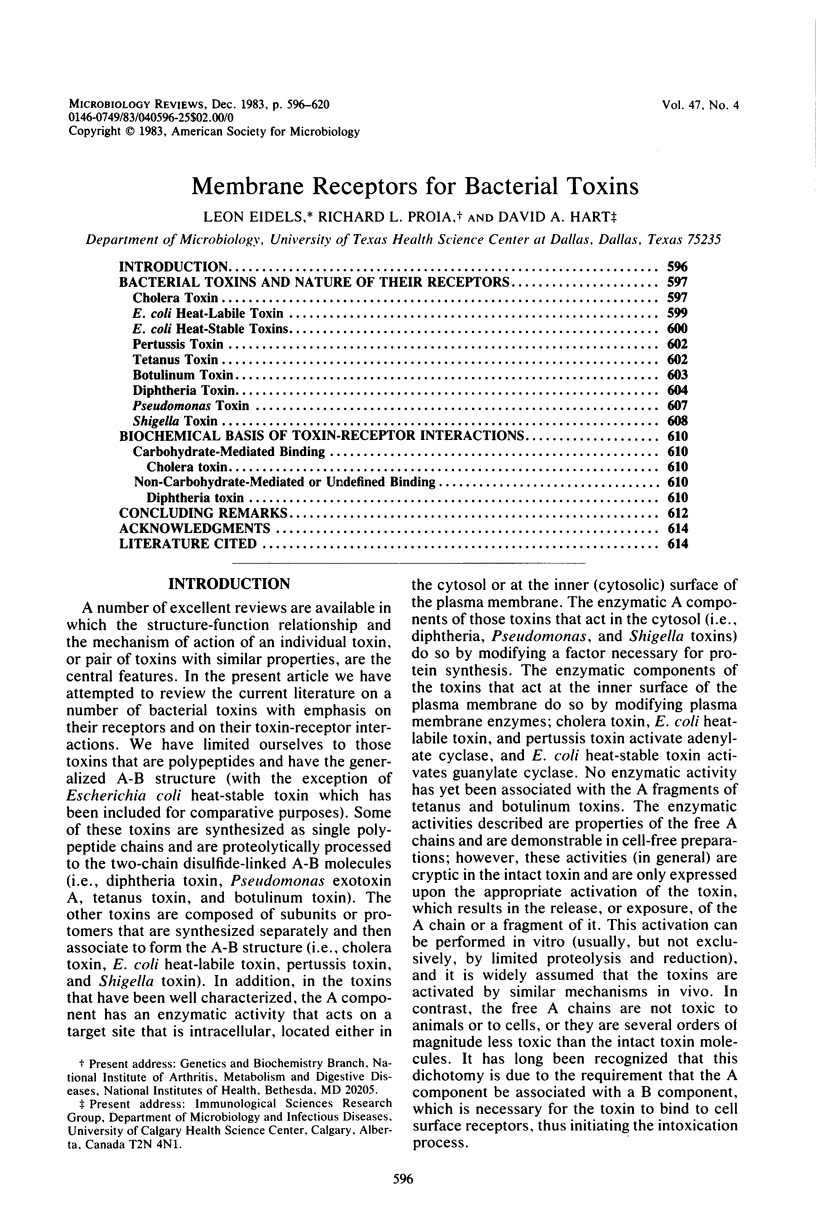
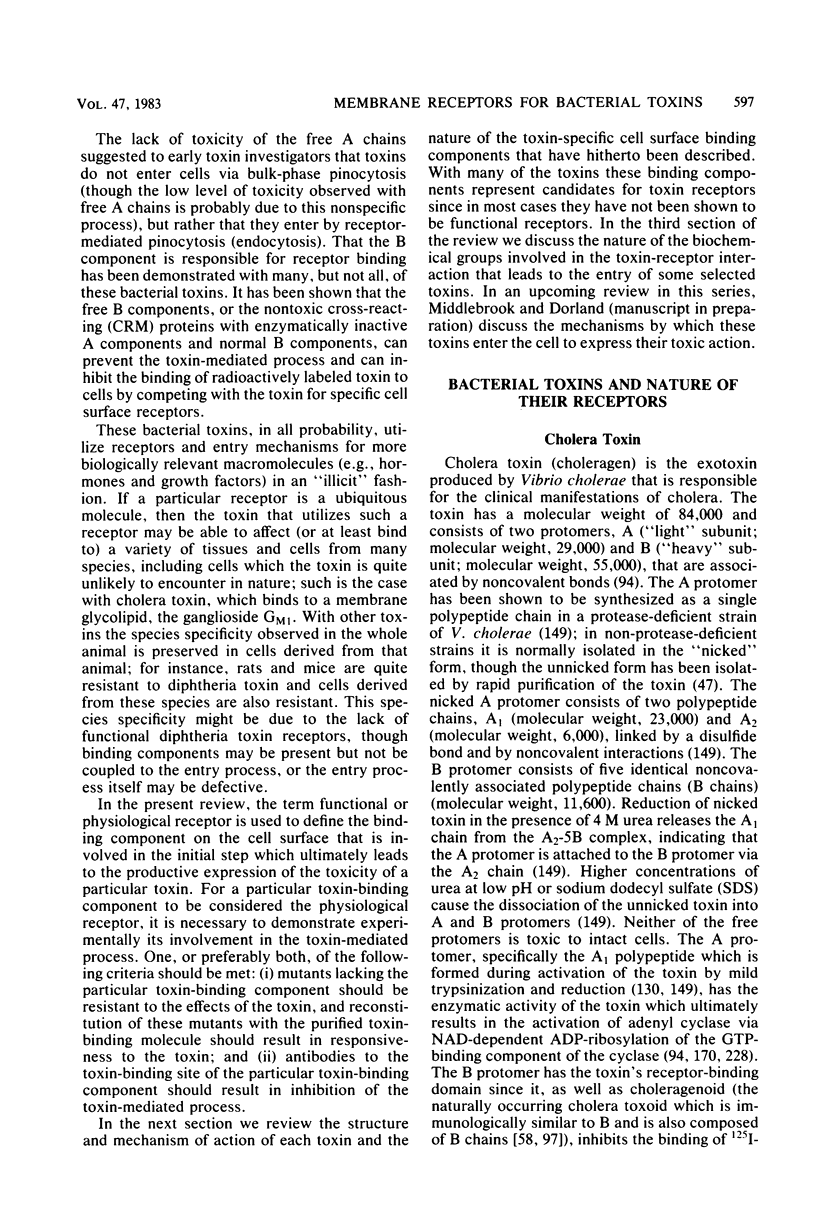
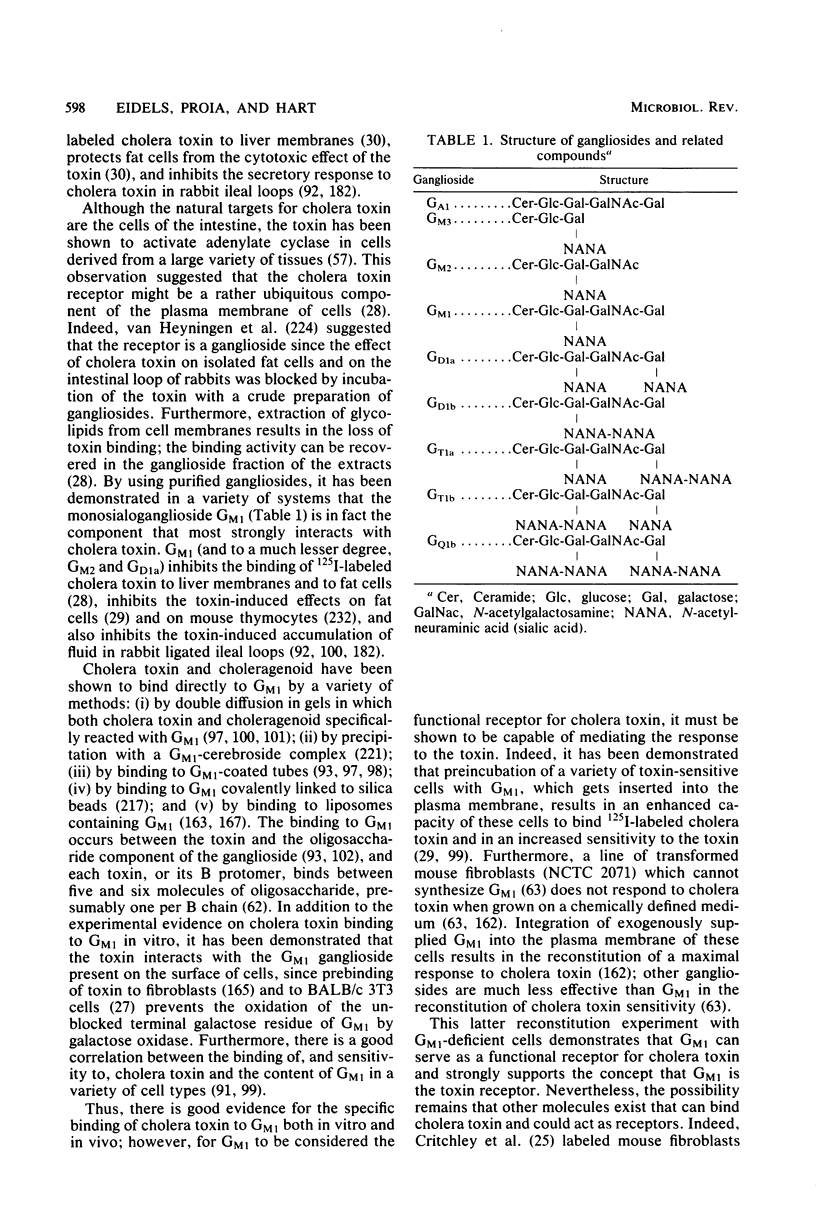
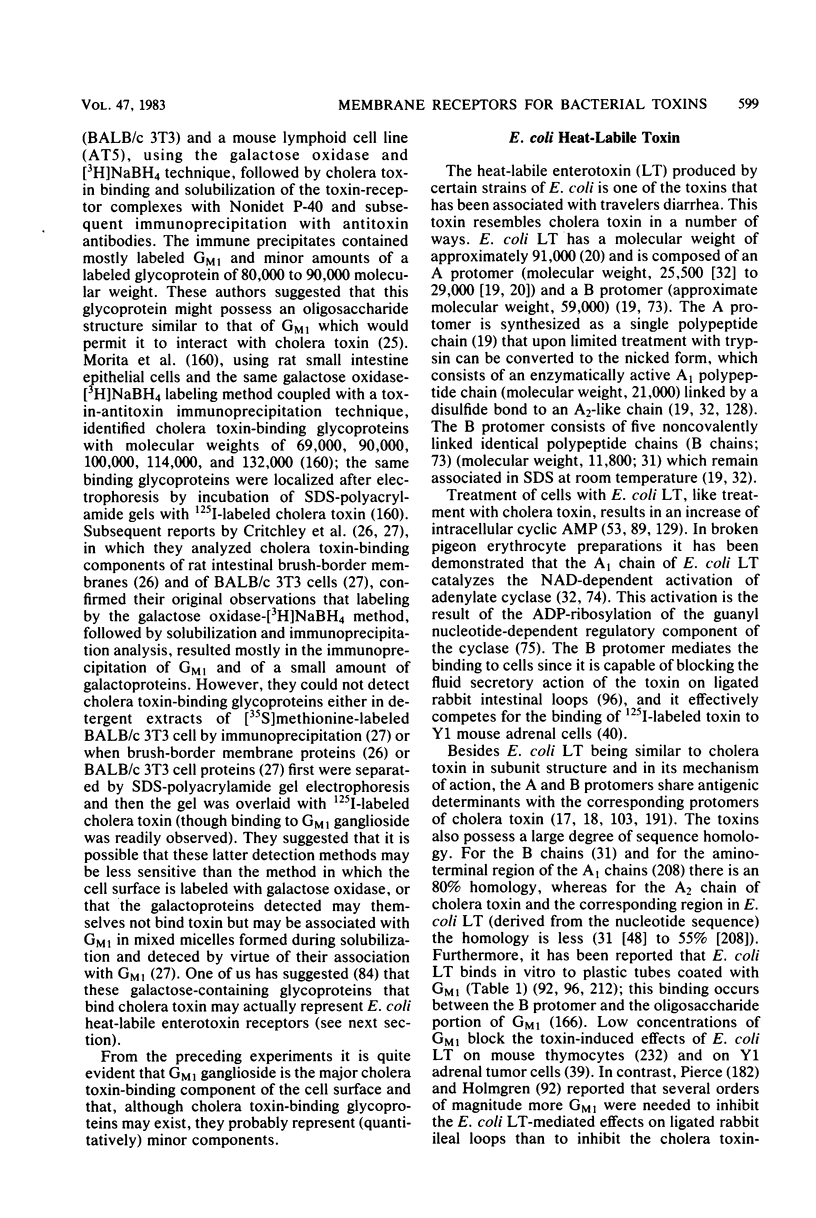
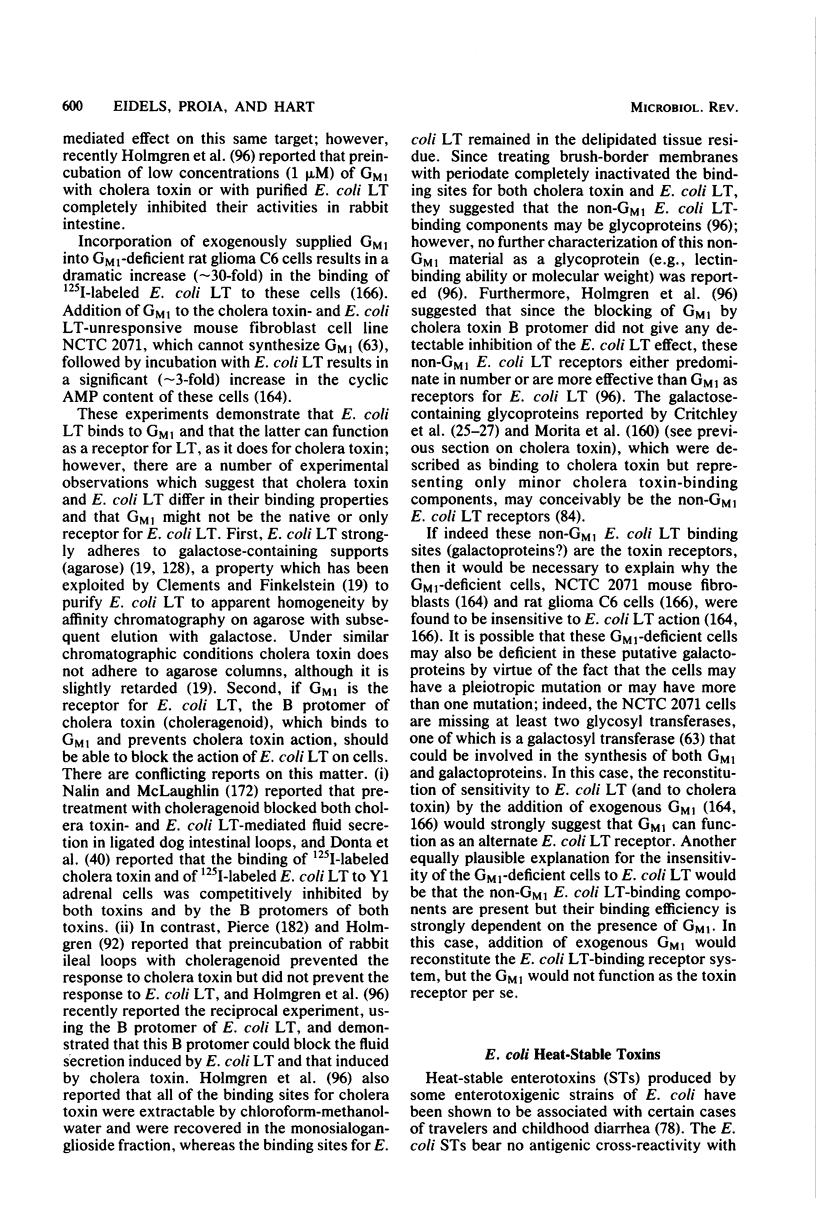
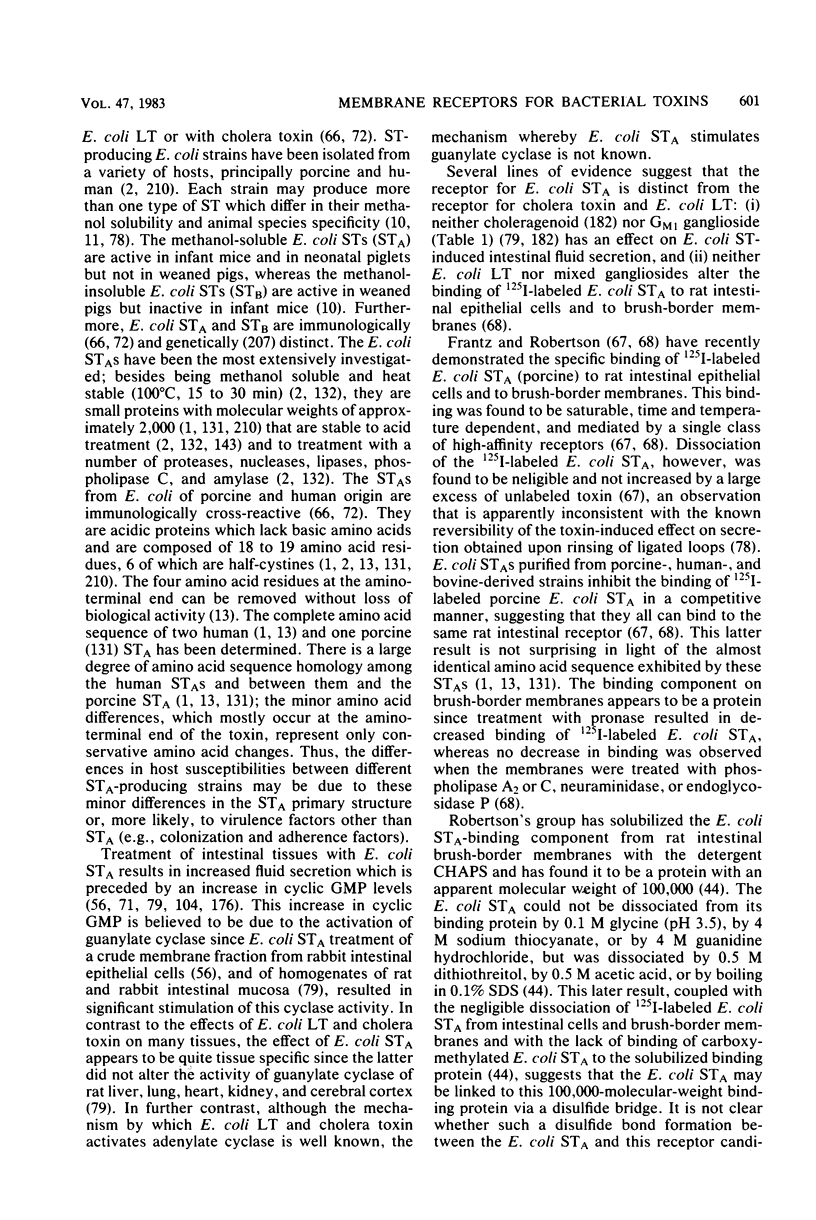
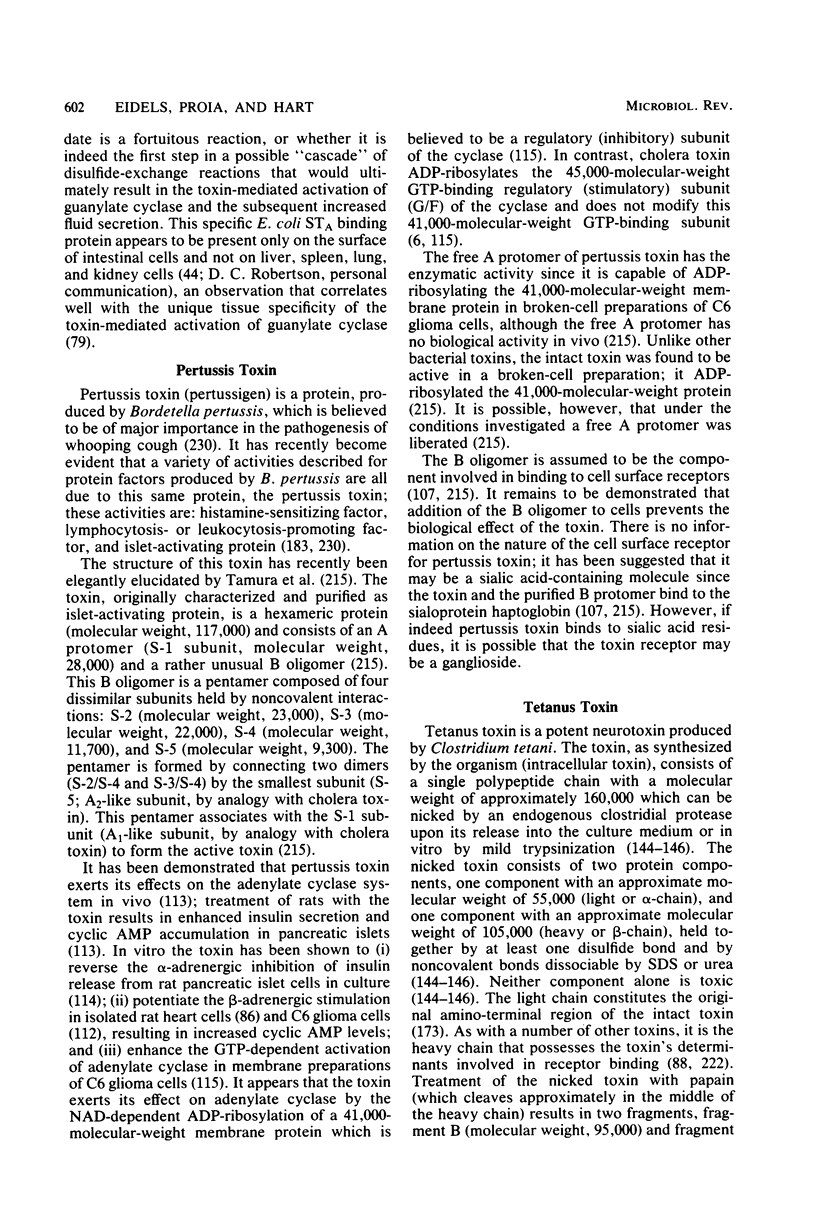
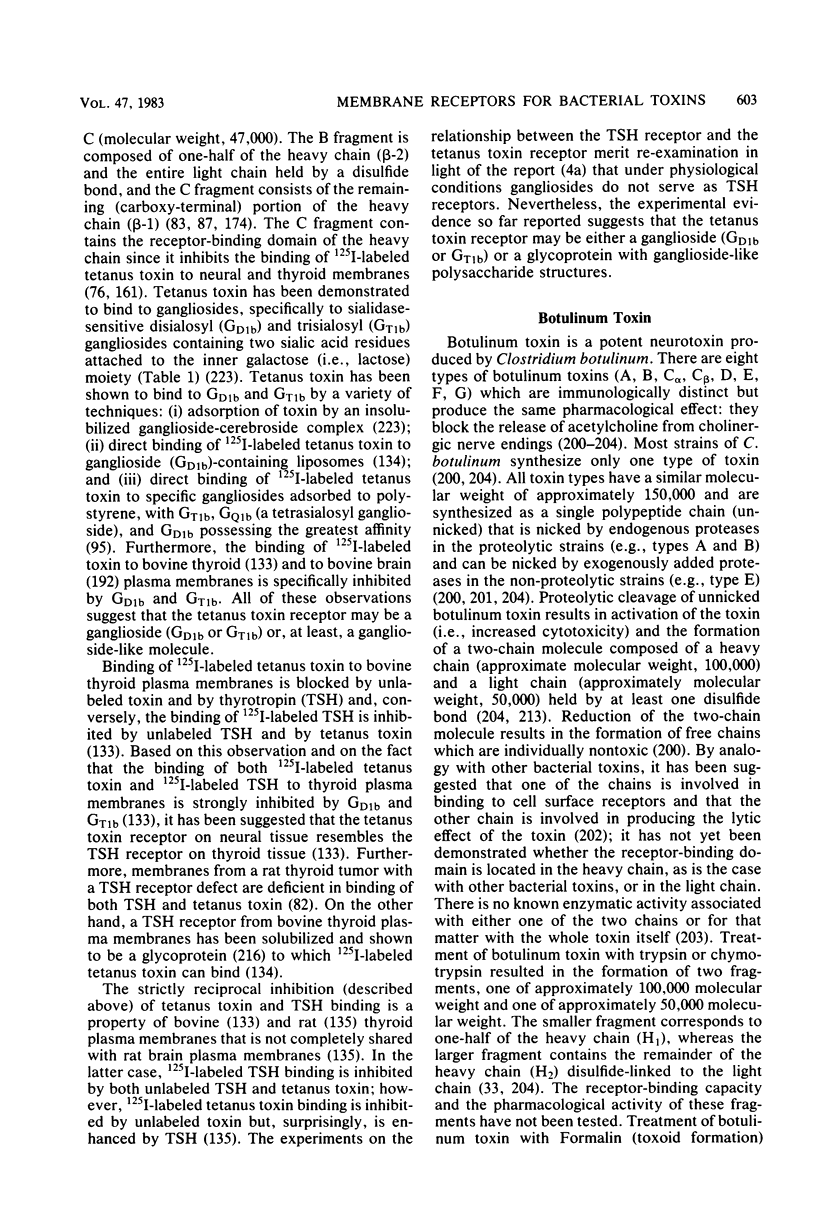
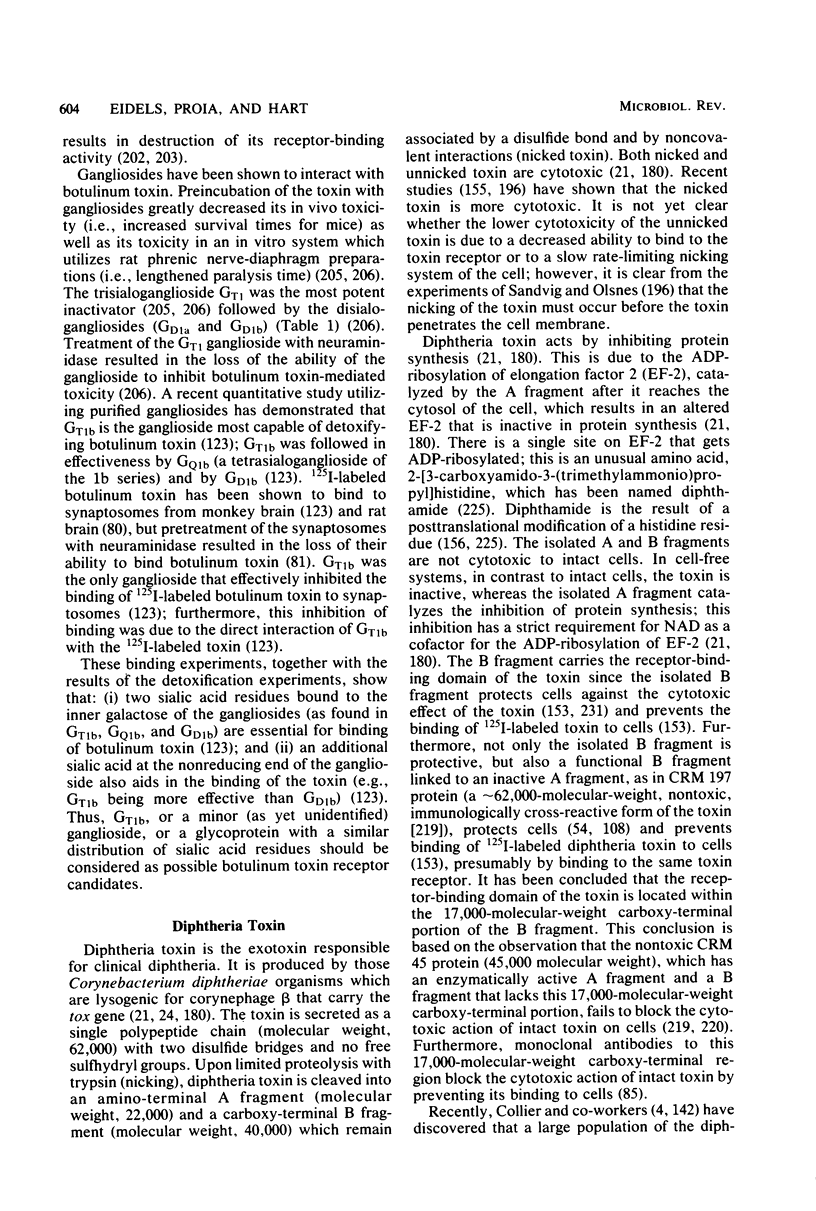
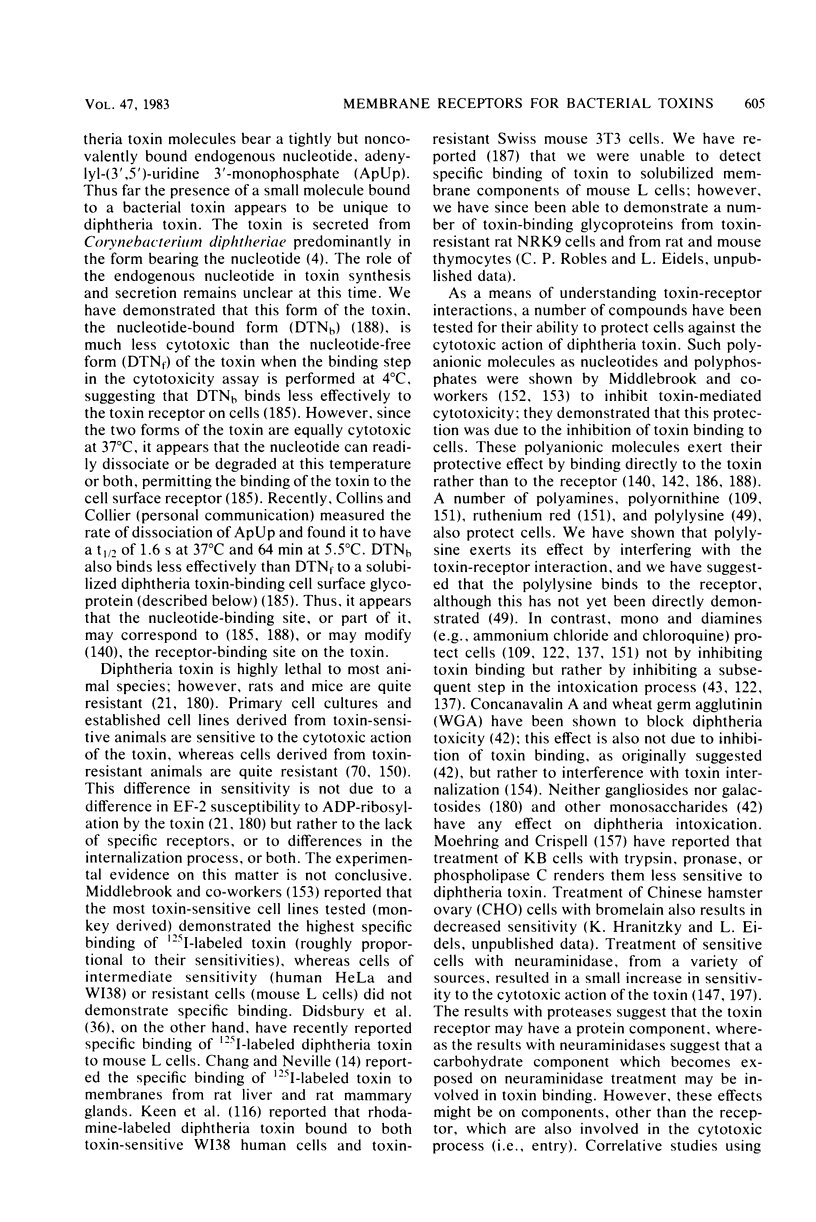
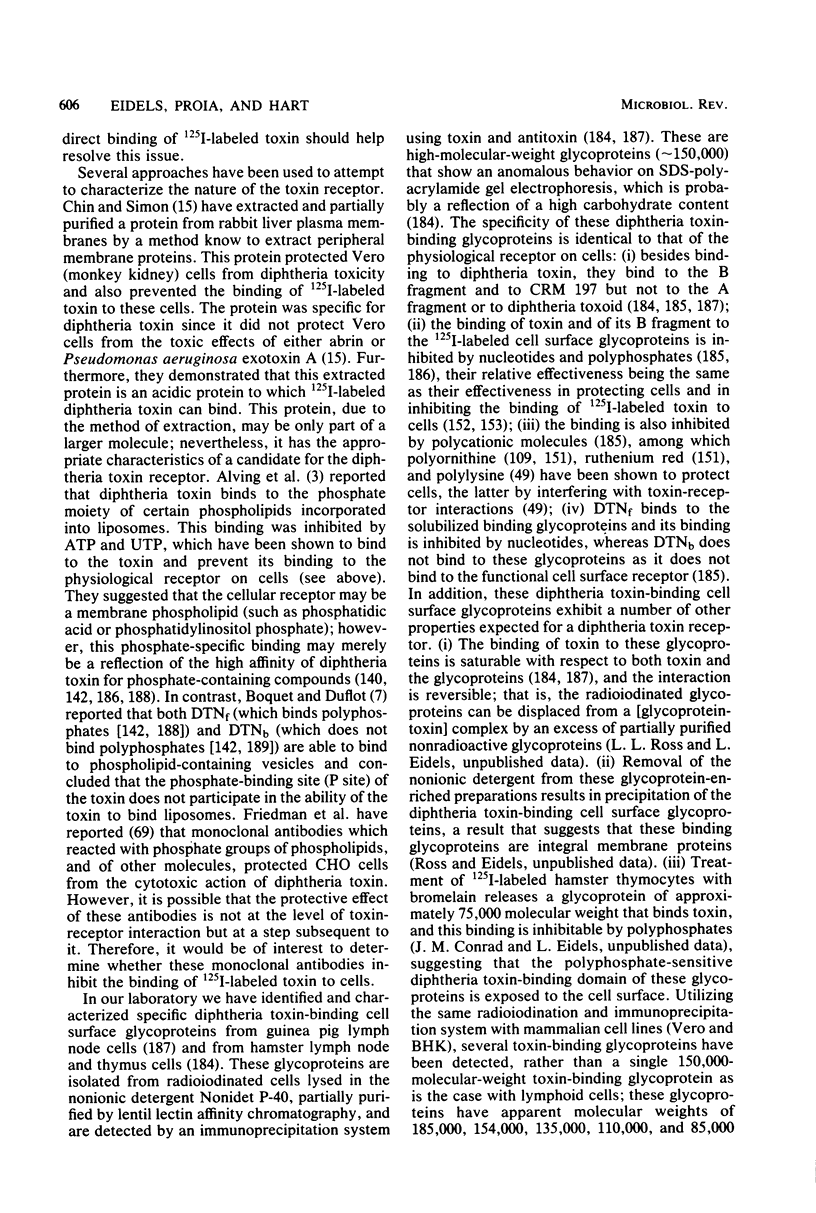
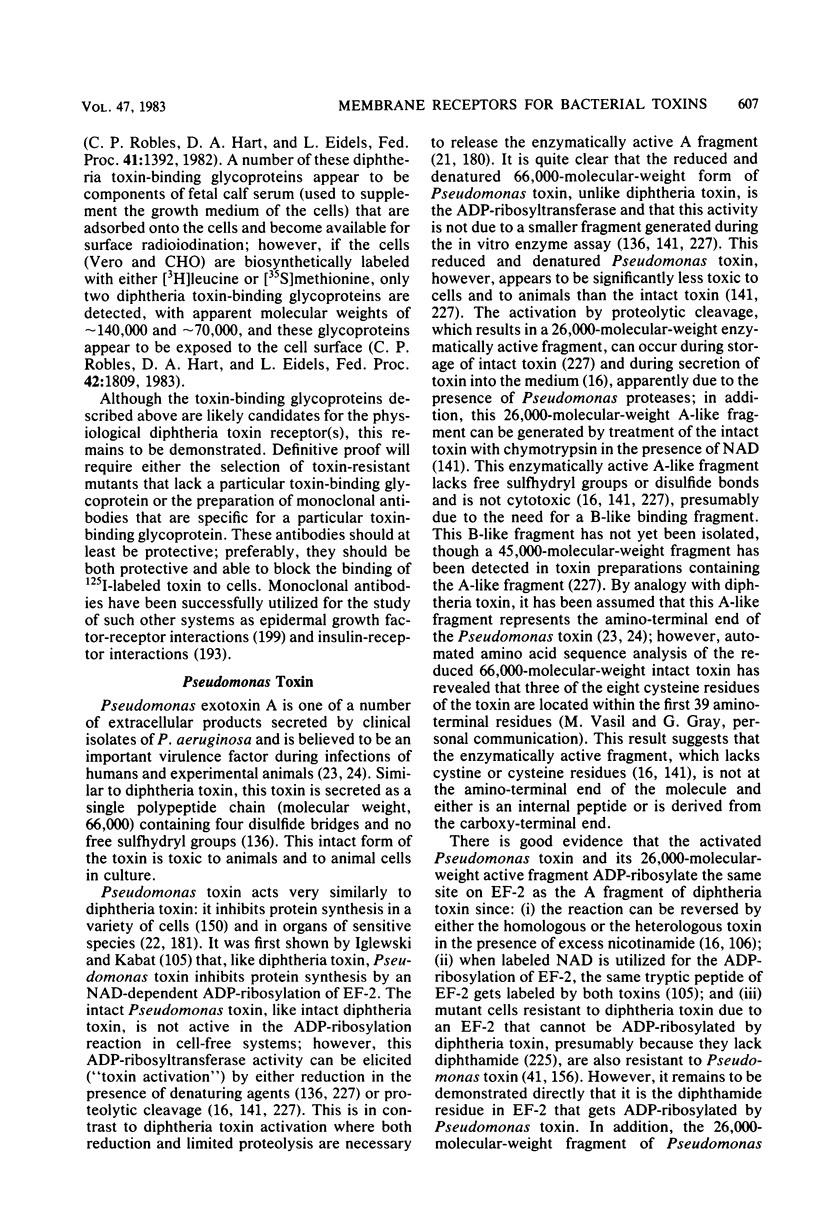
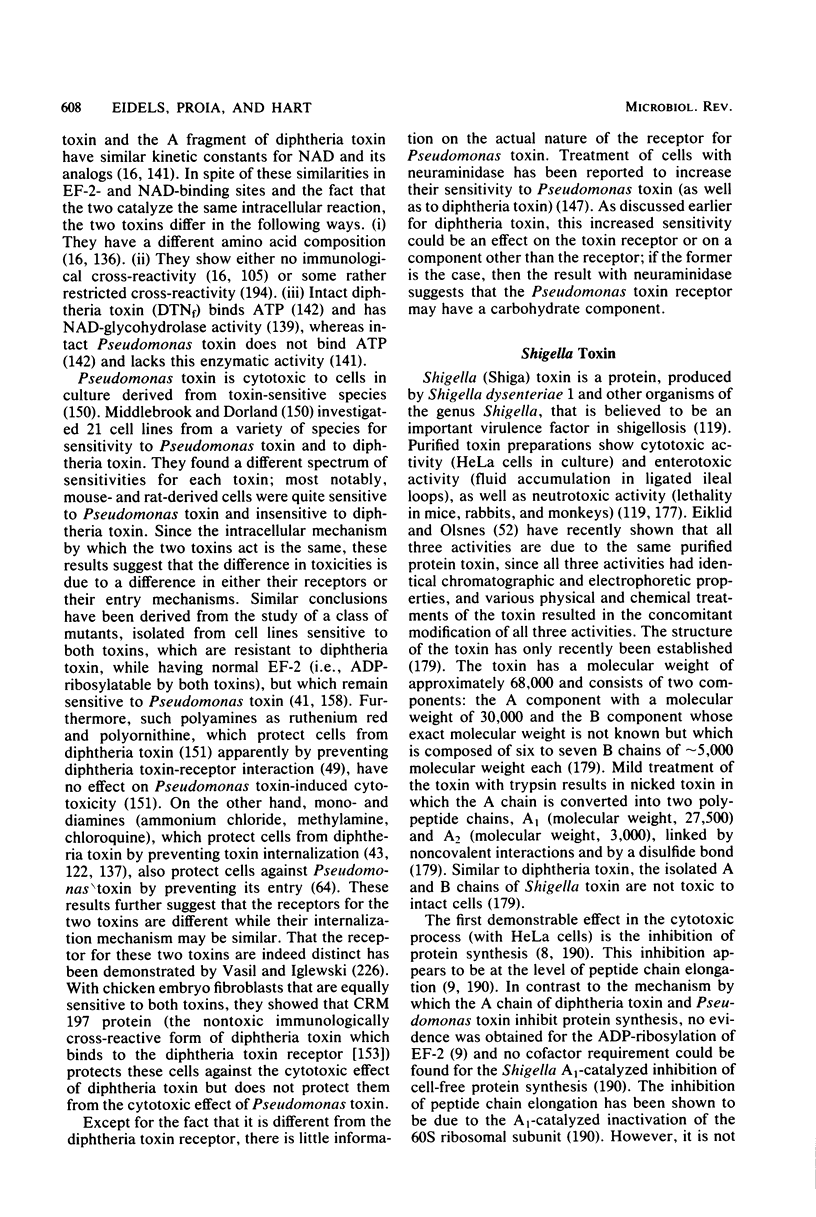
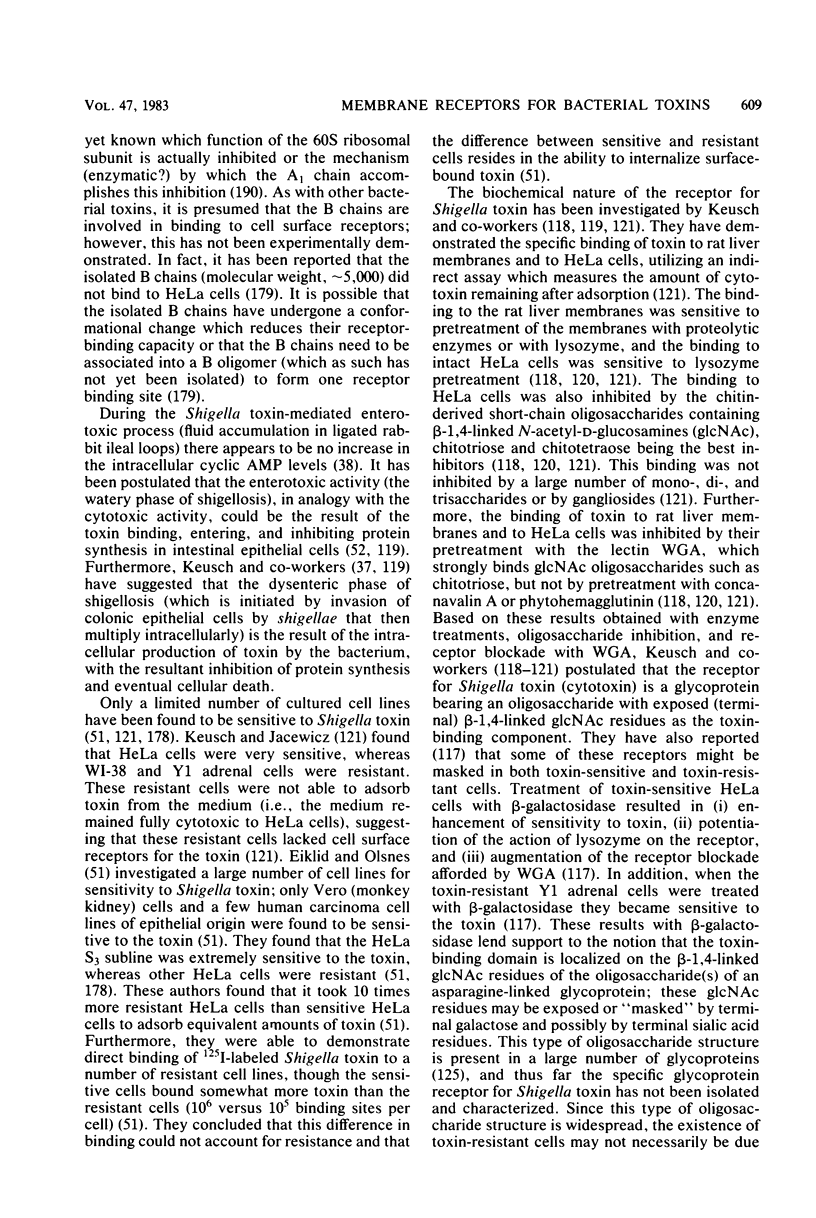
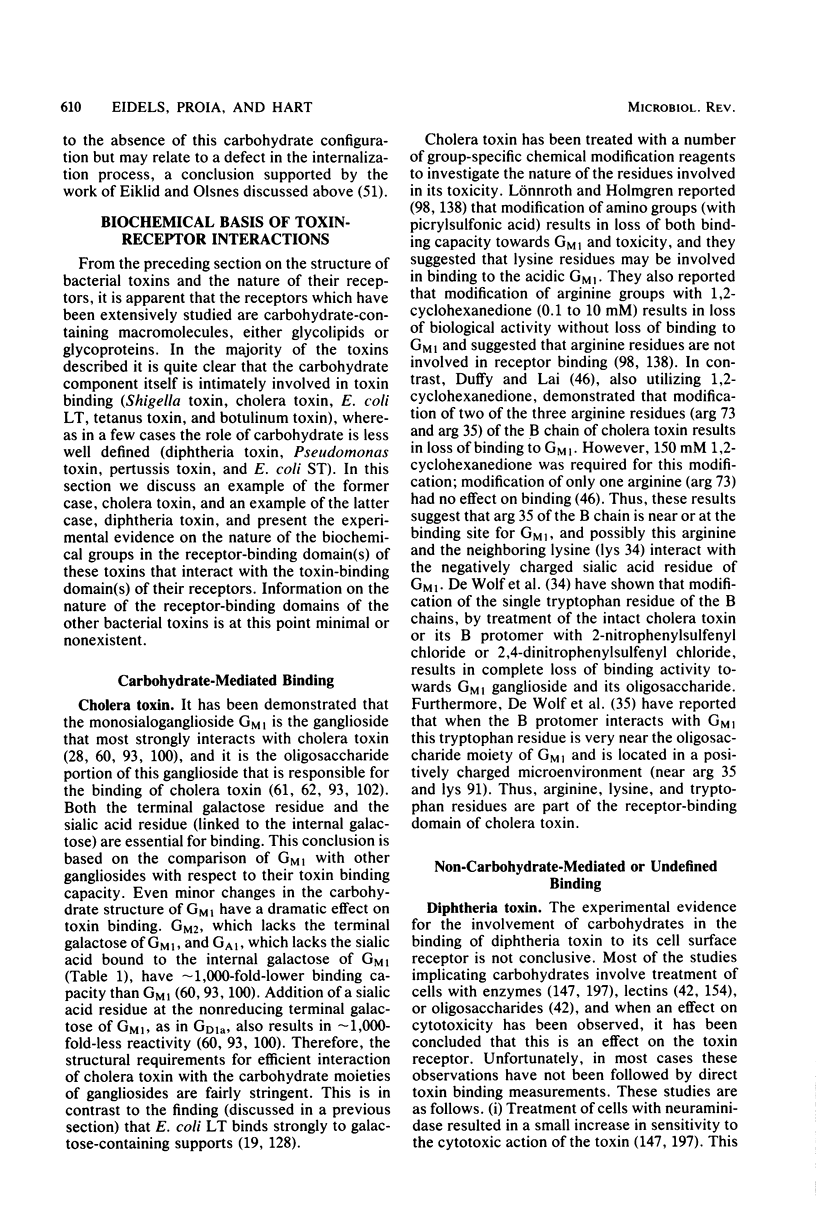
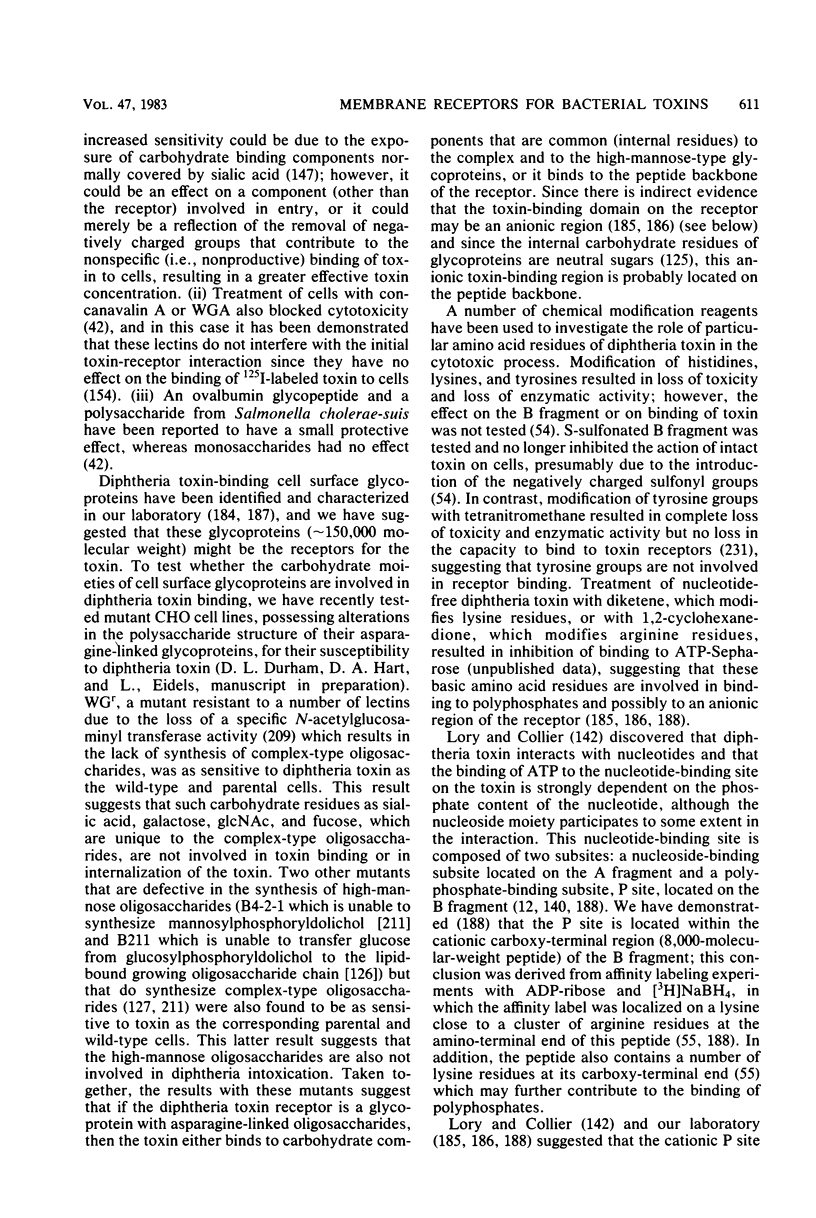
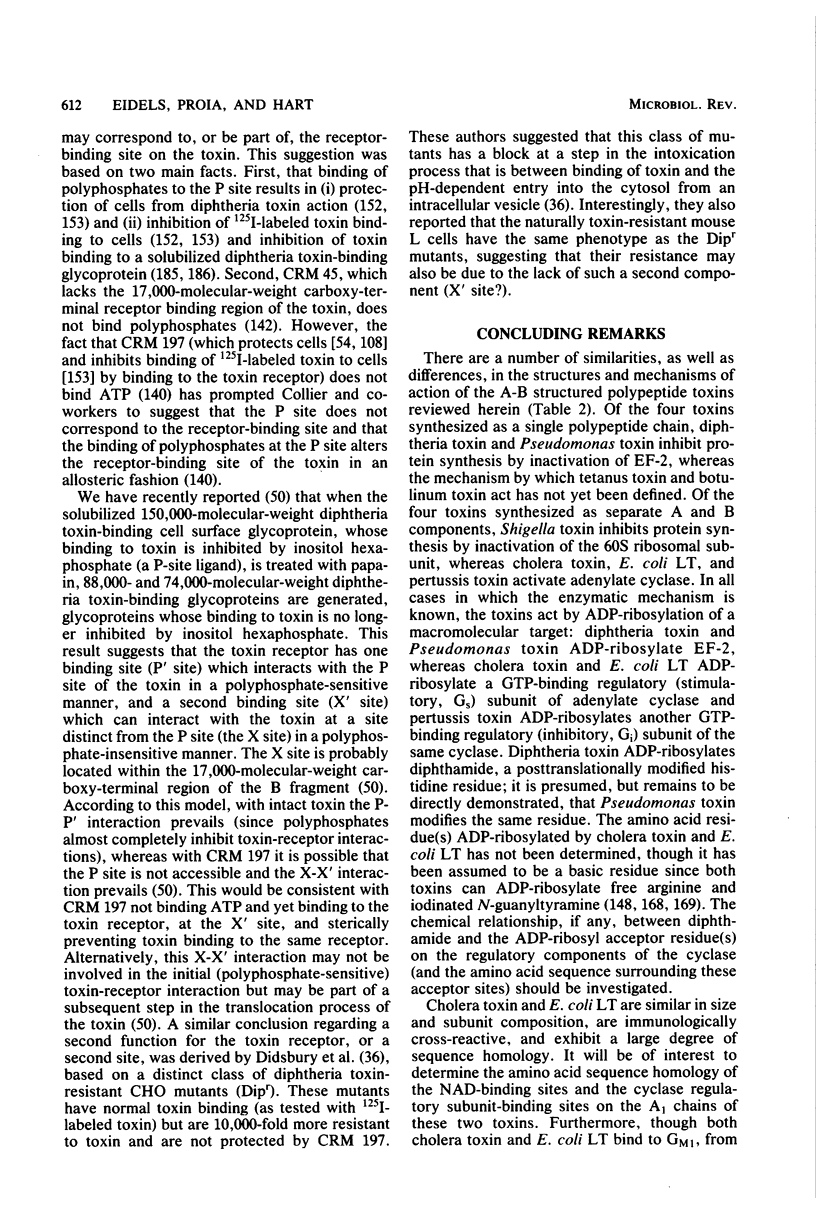
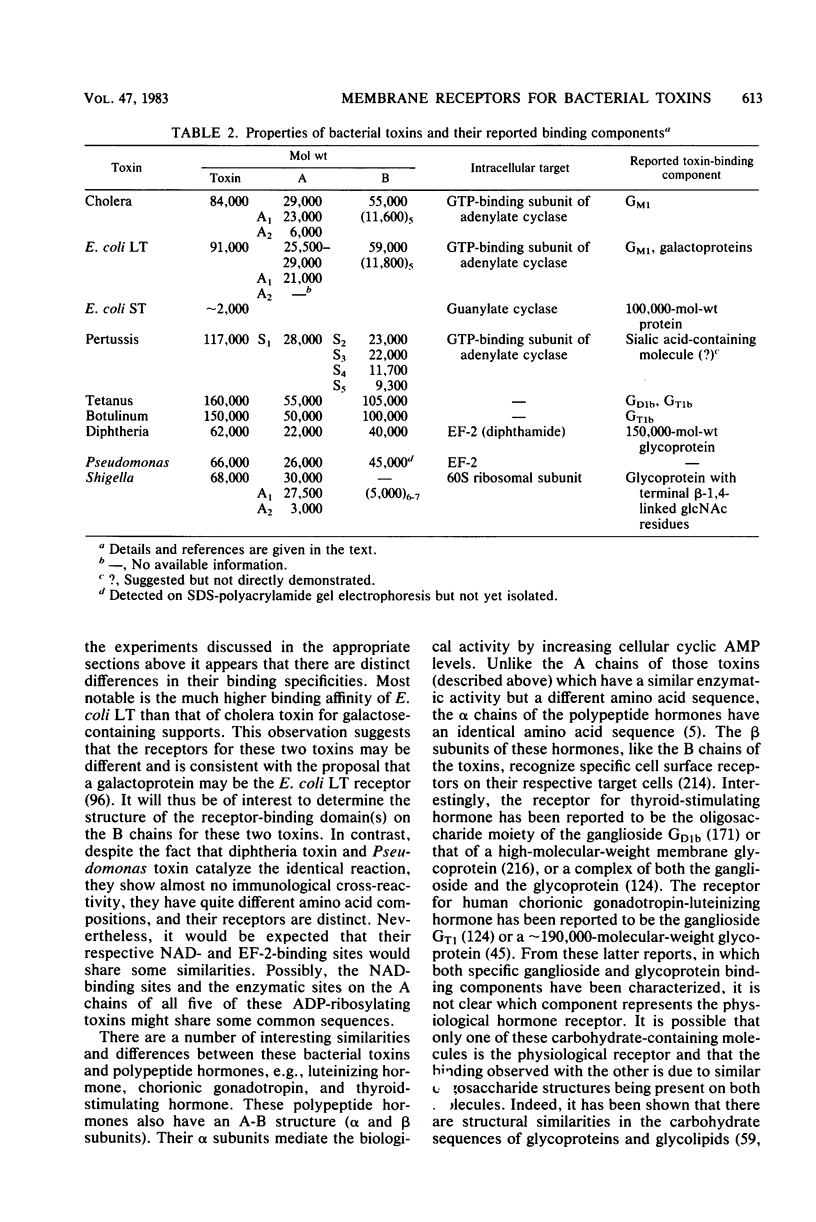
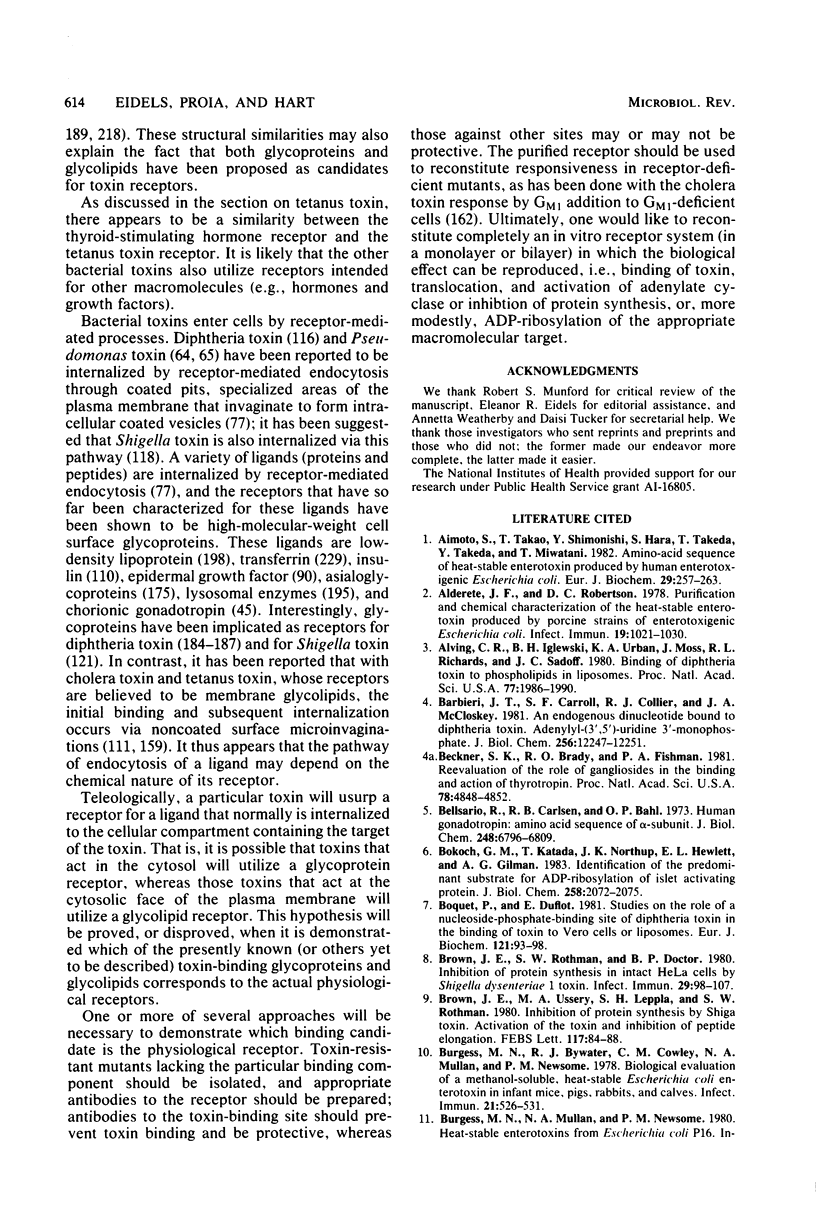
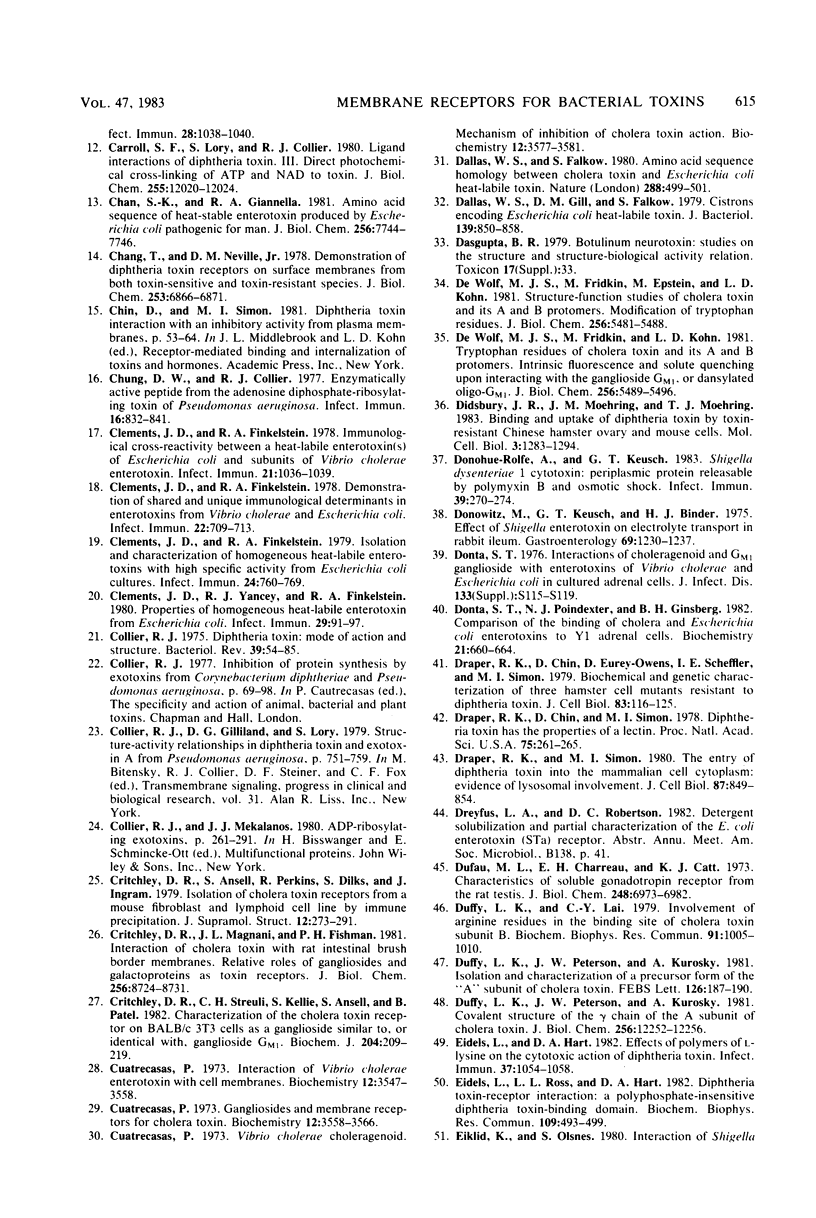
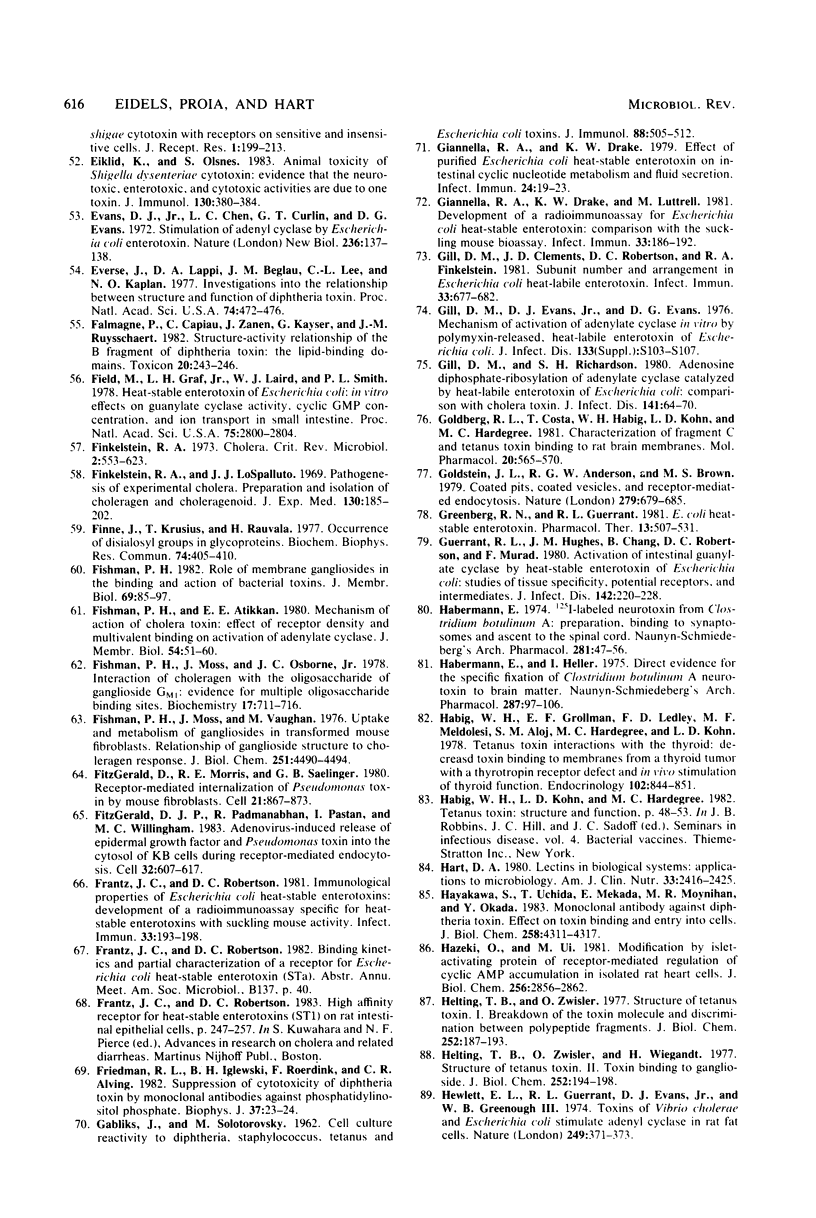
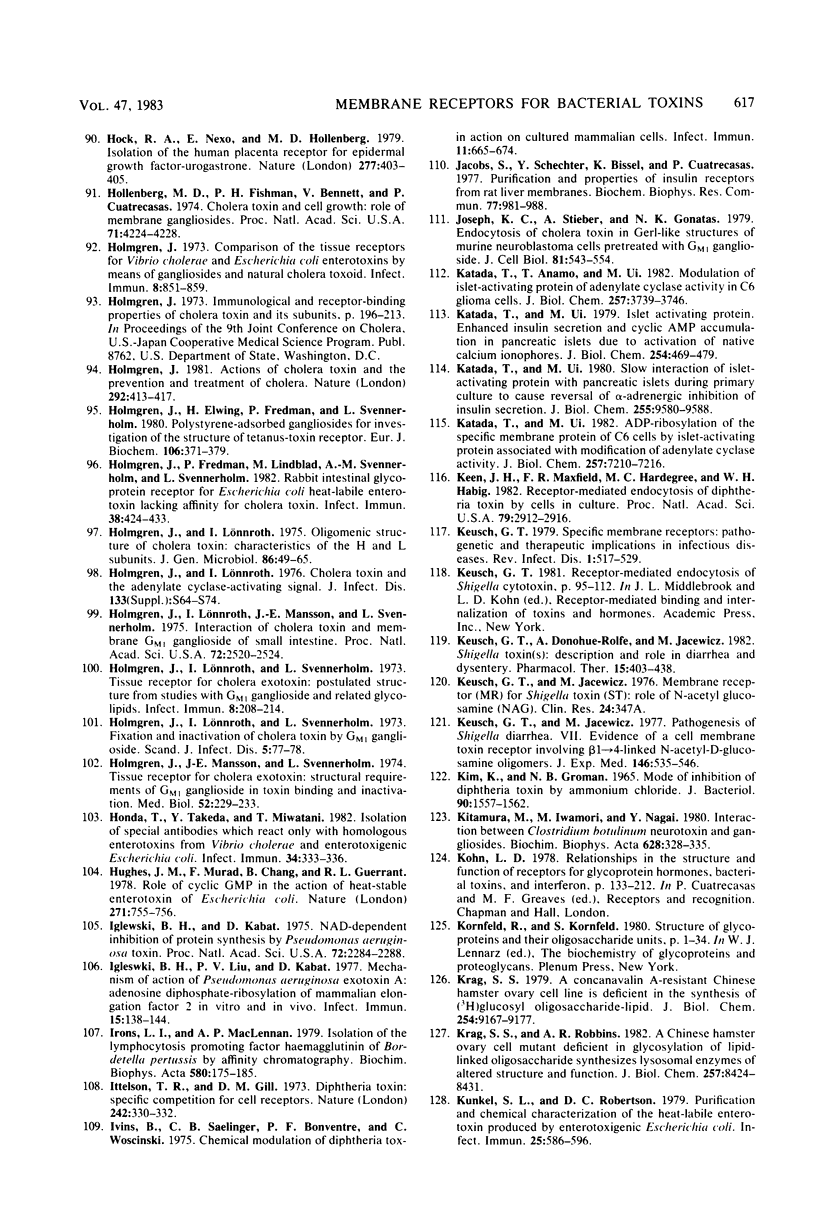
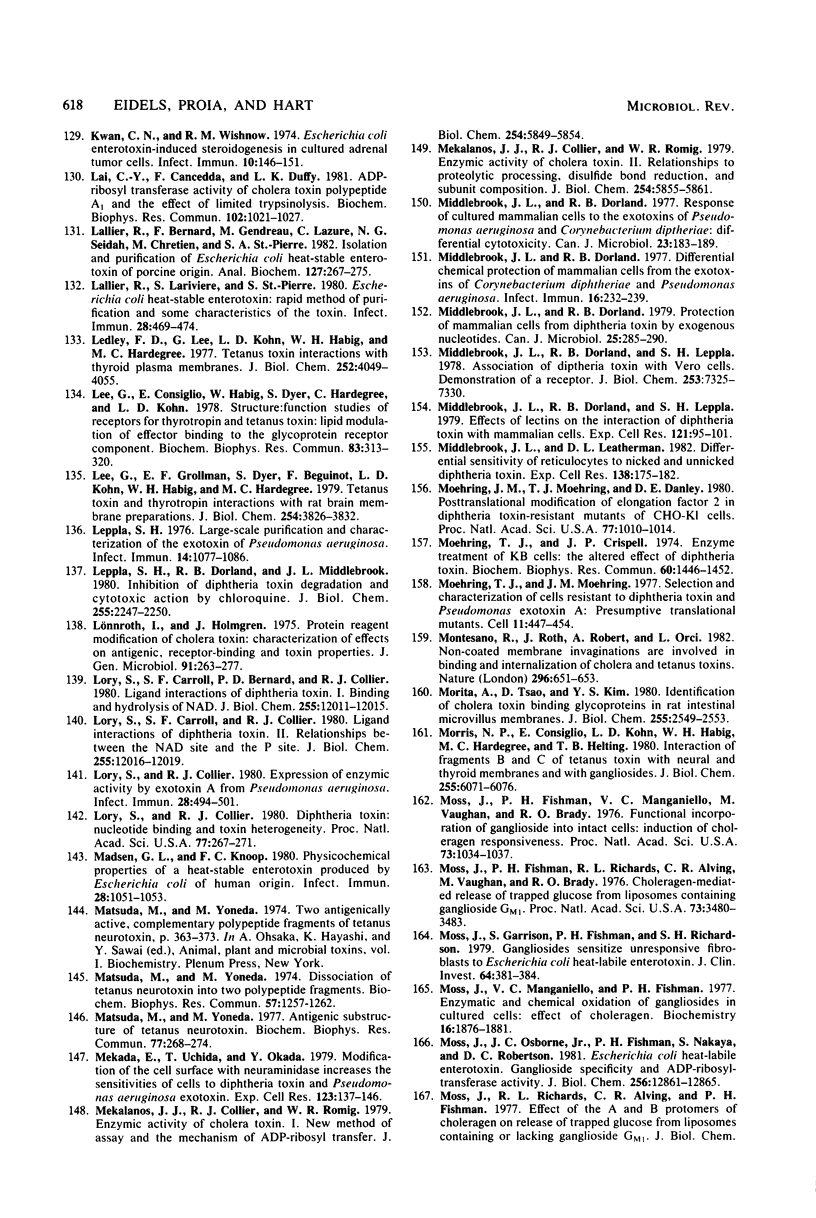
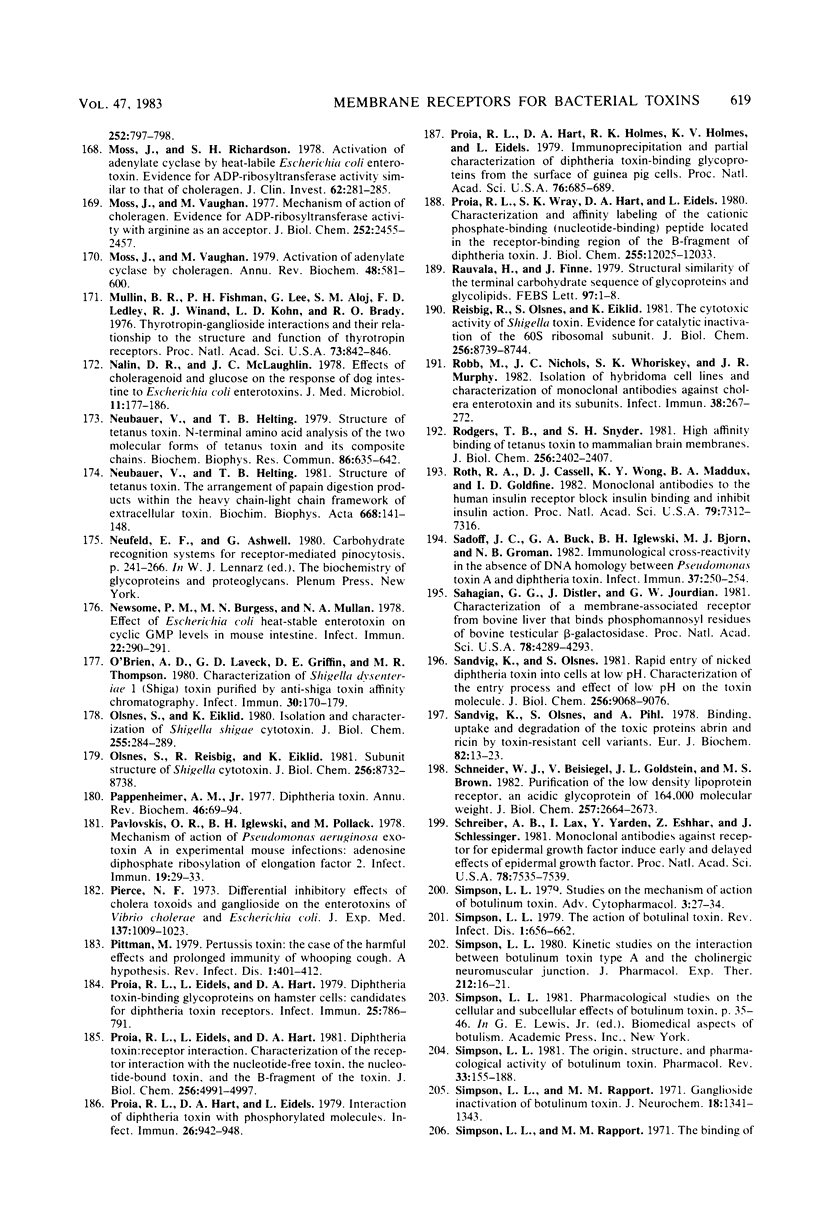
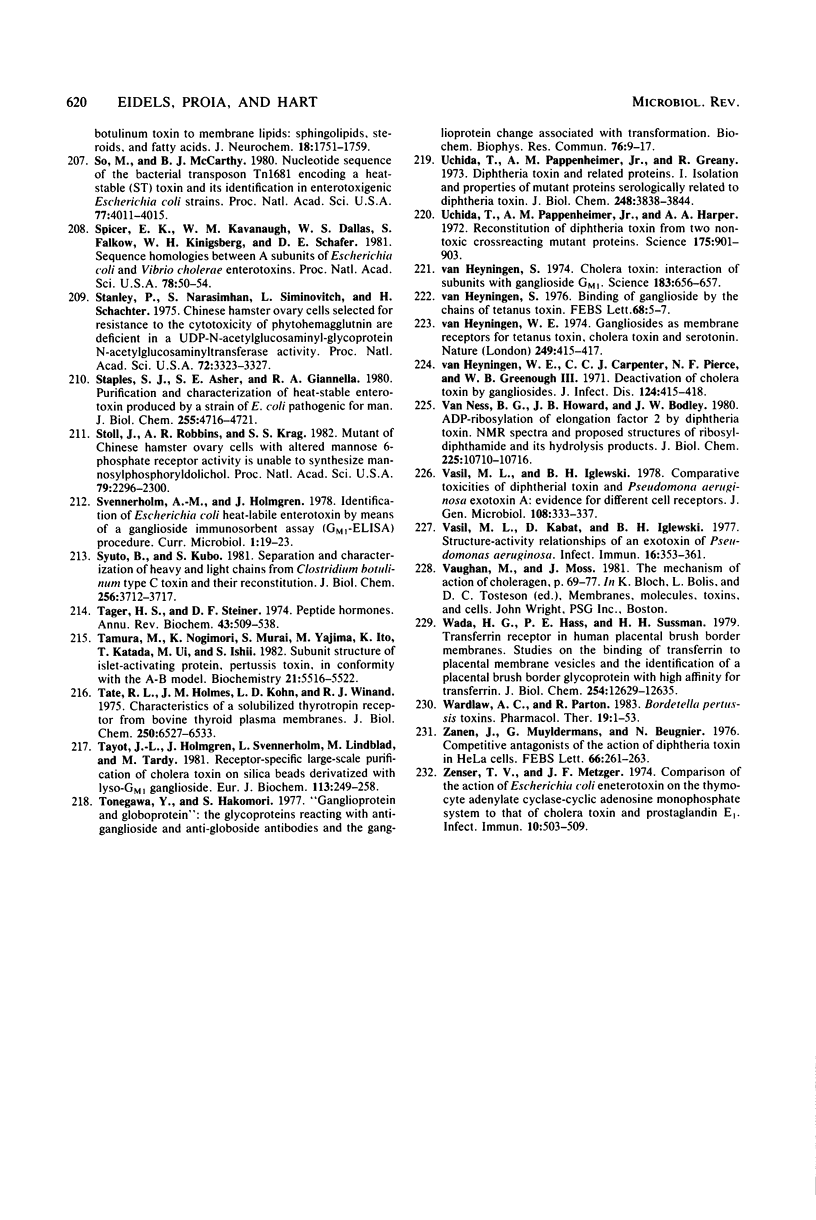
Selected References
These references are in PubMed. This may not be the complete list of references from this article.
- Aimoto S., Takao T., Shimonishi Y., Hara S., Takeda T., Takeda Y., Miwatani T. Amino-acid sequence of a heat-stable enterotoxin produced by human enterotoxigenic Escherichia coli. Eur J Biochem. 1982 Dec 15;129(2):257–263. doi: 10.1111/j.1432-1033.1982.tb07047.x. [DOI] [PubMed] [Google Scholar]
- Alderete J. F., Robertson D. C. Purification and chemical characterization of the heat-stable enterotoxin produced by porcine strains of enterotoxigenic Escherichia coli. Infect Immun. 1978 Mar;19(3):1021–1030. doi: 10.1128/iai.19.3.1021-1030.1978. [DOI] [PMC free article] [PubMed] [Google Scholar]
- Alving C. R., Iglewski B. H., Urban K. A., Moss J., Richards R. L., Sadoff J. C. Binding of diphtheria toxin to phospholipids in liposomes. Proc Natl Acad Sci U S A. 1980 Apr;77(4):1986–1990. doi: 10.1073/pnas.77.4.1986. [DOI] [PMC free article] [PubMed] [Google Scholar]
- Barbieri J. T., Carroll S. F., Collier R. J., McCloskey J. A. An endogenous dinucleotide bound to diphtheria toxin. Adenylyl-(3',5')-uridine 3'-monophosphate. J Biol Chem. 1981 Dec 10;256(23):12247–12251. [PubMed] [Google Scholar]
- Beckner S. K., Brady R. O., Fishman P. H. Reevaluation of the role of gangliosides in the binding and action of thyrotropin. Proc Natl Acad Sci U S A. 1981 Aug;78(8):4848–4852. doi: 10.1073/pnas.78.8.4848. [DOI] [PMC free article] [PubMed] [Google Scholar]
- Bellisario R., Carlsen R. B., Bahl O. P. Human chorionic gonadotropin. Linear amino acid sequence of the alpha subunit. J Biol Chem. 1973 Oct 10;248(19):6796–6809. [PubMed] [Google Scholar]
- Bokoch G. M., Katada T., Northup J. K., Hewlett E. L., Gilman A. G. Identification of the predominant substrate for ADP-ribosylation by islet activating protein. J Biol Chem. 1983 Feb 25;258(4):2072–2075. [PubMed] [Google Scholar]
- Boquet P., Duflot E. Studies on the role of a nucleoside-phosphate-binding site of diphtheria toxin in the binding of toxin to Vero cells or liposomes. Eur J Biochem. 1981 Dec;121(1):93–98. doi: 10.1111/j.1432-1033.1981.tb06435.x. [DOI] [PubMed] [Google Scholar]
- Brown J. E., Rothman S. W., Doctor B. P. Inhibition of protein synthesis in intact HeLa cells by Shigella dysenteriae 1 toxin. Infect Immun. 1980 Jul;29(1):98–107. doi: 10.1128/iai.29.1.98-107.1980. [DOI] [PMC free article] [PubMed] [Google Scholar]
- Brown J. E., Ussery M. A., Leppla S. H., Rothman S. W. Inhibition of protein synthesis by Shiga toxin: activation of the toxin and inhibition of peptide elongation. FEBS Lett. 1980 Aug 11;117(1):84–88. doi: 10.1016/0014-5793(80)80918-5. [DOI] [PubMed] [Google Scholar]
- Burgess M. N., Bywater R. J., Cowley C. M., Mullan N. A., Newsome P. M. Biological evaluation of a methanol-soluble, heat-stable Escherichia coli enterotoxin in infant mice, pigs, rabbits, and calves. Infect Immun. 1978 Aug;21(2):526–531. doi: 10.1128/iai.21.2.526-531.1978. [DOI] [PMC free article] [PubMed] [Google Scholar]
- Burgess M. N., Mullan N. A., Newsome P. M. Heat-stable enterotoxins from Escherichia coli P16. Infect Immun. 1980 Jun;28(3):1038–1040. doi: 10.1128/iai.28.3.1038-1040.1980. [DOI] [PMC free article] [PubMed] [Google Scholar]
- Carroll S. F., Lory S., Collier R. J. Ligand interactions of diphtheria toxin. III. Direct photochemical cross-linking of ATP and NAD to toxin. J Biol Chem. 1980 Dec 25;255(24):12020–12024. [PubMed] [Google Scholar]
- Chan S. K., Giannella R. A. Amino acid sequence of heat-stable enterotoxin produced by Escherichia coli pathogenic for man. J Biol Chem. 1981 Aug 10;256(15):7744–7746. [PubMed] [Google Scholar]
- Chang T., Neville D. M., Jr Demonstration of diphtheria toxin receptors on surface membranes from both toxin-sensitive and toxin-resistant species. J Biol Chem. 1978 Oct 10;253(19):6866–6871. [PubMed] [Google Scholar]
- Chung D. W., Collier R. J. Enzymatically active peptide from the adenosine diphosphate-ribosylating toxin of Pseudomonas aeruginosa. Infect Immun. 1977 Jun;16(3):832–841. doi: 10.1128/iai.16.3.832-841.1977. [DOI] [PMC free article] [PubMed] [Google Scholar]
- Clements J. D., Finkelstein R. A. Demonstration of shared and unique immunological determinants in enterotoxins from Vibrio cholerae and Escherichia coli. Infect Immun. 1978 Dec;22(3):709–713. doi: 10.1128/iai.22.3.709-713.1978. [DOI] [PMC free article] [PubMed] [Google Scholar]
- Clements J. D., Finkelstein R. A. Immunological cross-reactivity between a heat-labile enterotoxin(s) of Escherichia coli and subunits of Vibrio cholerae enterotoxin. Infect Immun. 1978 Sep;21(3):1036–1039. doi: 10.1128/iai.21.3.1036-1039.1978. [DOI] [PMC free article] [PubMed] [Google Scholar]
- Clements J. D., Finkelstein R. A. Isolation and characterization of homogeneous heat-labile enterotoxins with high specific activity from Escherichia coli cultures. Infect Immun. 1979 Jun;24(3):760–769. doi: 10.1128/iai.24.3.760-769.1979. [DOI] [PMC free article] [PubMed] [Google Scholar]
- Clements J. D., Yancey R. J., Finkelstein R. A. Properties of homogeneous heat-labile enterotoxin from Escherichia coli. Infect Immun. 1980 Jul;29(1):91–97. doi: 10.1128/iai.29.1.91-97.1980. [DOI] [PMC free article] [PubMed] [Google Scholar]
- Collier R. J. Diphtheria toxin: mode of action and structure. Bacteriol Rev. 1975 Mar;39(1):54–85. doi: 10.1128/br.39.1.54-85.1975. [DOI] [PMC free article] [PubMed] [Google Scholar]
- Collier R. J., Gilliland D. G., Lory S. Structure-activity relationships in diphtheria toxin and exotoxin A from Pseudomonas aeruginosa. Prog Clin Biol Res. 1979;31:751–759. [PubMed] [Google Scholar]
- Critchley D. R., Ansell S., Perkins R., Dilks S., Ingram J. Isolation of cholera toxin receptors from a mouse fibroblast and lymphoid cell line by immune precipitation. J Supramol Struct. 1979;12(2):273–291. doi: 10.1002/jss.400120211. [DOI] [PubMed] [Google Scholar]
- Critchley D. R., Magnani J. L., Fishman P. H. Interaction of cholera toxin with rat intestinal brush border membranes. Relative roles of gangliosides and galactoproteins as toxin receptors. J Biol Chem. 1981 Aug 25;256(16):8724–8731. [PubMed] [Google Scholar]
- Critchley D. R., Streuli C. H., Kellie S., Ansell S., Patel B. Characterization of the cholera toxin receptor on Balb/c 3T3 cells as a ganglioside similar to, or identical with, ganglioside GM1. No evidence for galactoproteins with receptor activity. Biochem J. 1982 Apr 15;204(1):209–219. doi: 10.1042/bj2040209. [DOI] [PMC free article] [PubMed] [Google Scholar]
- Cuatrecasas P. Gangliosides and membrane receptors for cholera toxin. Biochemistry. 1973 Aug 28;12(18):3558–3566. doi: 10.1021/bi00742a032. [DOI] [PubMed] [Google Scholar]
- Cuatrecasas P. Interaction of Vibrio cholerae enterotoxin with cell membranes. Biochemistry. 1973 Aug 28;12(18):3547–3558. doi: 10.1021/bi00742a031. [DOI] [PubMed] [Google Scholar]
- Cuatrecasas P. Vibrio cholerae choleragenoid. Mechanism of inhibition of cholera toxin action. Biochemistry. 1973 Aug 28;12(18):3577–3581. doi: 10.1021/bi00742a034. [DOI] [PubMed] [Google Scholar]
- Dallas W. S., Falkow S. Amino acid sequence homology between cholera toxin and Escherichia coli heat-labile toxin. Nature. 1980 Dec 4;288(5790):499–501. doi: 10.1038/288499a0. [DOI] [PubMed] [Google Scholar]
- Dallas W. S., Gill D. M., Falkow S. Cistrons encoding Escherichia coli heat-labile toxin. J Bacteriol. 1979 Sep;139(3):850–858. doi: 10.1128/jb.139.3.850-858.1979. [DOI] [PMC free article] [PubMed] [Google Scholar]
- De Wolf M. J., Fridkin M., Epstein M., Kohn L. D. Structure-function studies of cholera toxin and its A and B protomers. Modification of tryptophan residues. J Biol Chem. 1981 Jun 10;256(11):5481–5488. [PubMed] [Google Scholar]
- De Wolf M. J., Fridkin M., Kohn L. D. Tryptophan residues of cholera toxin and its A and B protomers. Intrinsic fluorescence and solute quenching upon interacting with the ganglioside GM1, oligo-GM1, or dansylated oligo-GM1. J Biol Chem. 1981 Jun 10;256(11):5489–5496. [PubMed] [Google Scholar]
- Didsbury J. R., Moehring J. M., Moehring T. J. Binding and uptake of diphtheria toxin by toxin-resistant Chinese hamster ovary and mouse cells. Mol Cell Biol. 1983 Jul;3(7):1283–1294. doi: 10.1128/mcb.3.7.1283. [DOI] [PMC free article] [PubMed] [Google Scholar]
- Donohue-Rolfe A., Keusch G. T. Shigella dysenteriae 1 cytotoxin: periplasmic protein releasable by polymyxin B and osmotic shock. Infect Immun. 1983 Jan;39(1):270–274. doi: 10.1128/iai.39.1.270-274.1983. [DOI] [PMC free article] [PubMed] [Google Scholar]
- Donowitz M., Keusch G. T., Binder H. J. Effect of Shigella enterotoxin on electrolyte transport in rabbit ileum. Gastroenterology. 1975 Dec;69(6):1230–1237. [PubMed] [Google Scholar]
- Donta S. T., Poindexter N. J., Ginsberg B. H. Comparison of the binding of cholera and Escherichia coli enterotoxins to Y1 adrenal cells. Biochemistry. 1982 Feb 16;21(4):660–664. doi: 10.1021/bi00533a011. [DOI] [PubMed] [Google Scholar]
- Draper R. K., Chin D., Eurey-Owens D., Scheffler I. E., Simon M. I. Biochemical and genetic characterization of three hamster cell mutants resistant to diphtheria toxin. J Cell Biol. 1979 Oct;83(1):116–125. doi: 10.1083/jcb.83.1.116. [DOI] [PMC free article] [PubMed] [Google Scholar]
- Draper R. K., Chin D., Simon M. I. Diphtheria toxin has the properties of a lectin. Proc Natl Acad Sci U S A. 1978 Jan;75(1):261–265. doi: 10.1073/pnas.75.1.261. [DOI] [PMC free article] [PubMed] [Google Scholar]
- Draper R. K., Simon M. I. The entry of diphtheria toxin into the mammalian cell cytoplasm: evidence for lysosomal involvement. J Cell Biol. 1980 Dec;87(3 Pt 1):849–854. doi: 10.1083/jcb.87.3.849. [DOI] [PMC free article] [PubMed] [Google Scholar]
- Dufau M. L., Charreau E. H., Catt K. J. Characteristics of a soluble gonadotropin receptor from the rat testis. J Biol Chem. 1973 Oct 25;248(20):6973–6982. [PubMed] [Google Scholar]
- Duffy L. K., Lai C. Y. Involvement of arginine residues in the binding site of cholera toxin subunit B. Biochem Biophys Res Commun. 1979 Dec 14;91(3):1005–1010. doi: 10.1016/0006-291x(79)91979-x. [DOI] [PubMed] [Google Scholar]
- Duffy L. K., Peterson J. W., Kurosky A. Covalent structure of the gamma chain of the A subunit of cholera toxin. J Biol Chem. 1981 Dec 10;256(23):12252–12256. [PubMed] [Google Scholar]
- Duffy L. K., Peterson J. W., Kurosky A. Isolation and characterization of a precursor form of the 'A' subunit of cholera toxin. FEBS Lett. 1981 Apr 20;126(2):187–190. doi: 10.1016/0014-5793(81)80238-4. [DOI] [PubMed] [Google Scholar]
- Eidels L., Hart D. A. Effect of polymers of L-lysine on the cytotoxic action of diphtheria toxin. Infect Immun. 1982 Sep;37(3):1054–1058. doi: 10.1128/iai.37.3.1054-1058.1982. [DOI] [PMC free article] [PubMed] [Google Scholar]
- Eidels L., Ross L. L., Hart D. A. Diphtheria toxin-receptor interaction: a polyphosphate-insensitive diphtheria toxin-binding domain. Biochem Biophys Res Commun. 1982 Nov 30;109(2):493–499. doi: 10.1016/0006-291x(82)91748-x. [DOI] [PubMed] [Google Scholar]
- Eiklid K., Olsnes S. Animal toxicity of Shigella dysenteriae cytotoxin: evidence that the neurotoxic, enterotoxic, and cytotoxic activities are due to one toxin. J Immunol. 1983 Jan;130(1):380–384. [PubMed] [Google Scholar]
- Evans D. J., Jr, Chen L. C., Curlin G. T., Evans D. G. Stimulation of adenyl cyclase by Escherichia coli enterotoxin. Nat New Biol. 1972 Apr 5;236(66):137–138. doi: 10.1038/newbio236137a0. [DOI] [PubMed] [Google Scholar]
- Everse J., Lappi D. A., Beglau J. M., Lee C. L., Kaplan N. O. Investigations into the relationship between structure and function of diphtheria toxin. Proc Natl Acad Sci U S A. 1977 Feb;74(2):472–476. doi: 10.1073/pnas.74.2.472. [DOI] [PMC free article] [PubMed] [Google Scholar]
- Falmagne P., Capiau C., Zanen J., Kayser G., Ruysschaert J. M. Structure-activity relationships of the B fragment of diphtheria toxin: the lipid-binding domains. Toxicon. 1982;20(1):243–246. doi: 10.1016/0041-0101(82)90209-4. [DOI] [PubMed] [Google Scholar]
- Field M., Graf L. H., Jr, Laird W. J., Smith P. L. Heat-stable enterotoxin of Escherichia coli: in vitro effects on guanylate cyclase activity, cyclic GMP concentration, and ion transport in small intestine. Proc Natl Acad Sci U S A. 1978 Jun;75(6):2800–2804. doi: 10.1073/pnas.75.6.2800. [DOI] [PMC free article] [PubMed] [Google Scholar]
- Finkelstein R. A., LoSpalluto J. J. Pathogenesis of experimental cholera. Preparation and isolation of choleragen and choleragenoid. J Exp Med. 1969 Jul 1;130(1):185–202. doi: 10.1084/jem.130.1.185. [DOI] [PMC free article] [PubMed] [Google Scholar]
- Finne J., Krusius T., Rauvala H. Occurrence of disialosyl groups in glycoproteins. Biochem Biophys Res Commun. 1977 Jan 24;74(2):405–410. doi: 10.1016/0006-291x(77)90318-7. [DOI] [PubMed] [Google Scholar]
- Fishman P. H., Atikkan E. E. Mechanism of action of cholera toxin: effect of receptor density and multivalent binding on activation of adenylate cyclase. J Membr Biol. 1980;54(1):51–60. doi: 10.1007/BF01875376. [DOI] [PubMed] [Google Scholar]
- Fishman P. H., Moss J., Osborne J. C., Jr Interaction of choleragen with the oligosaccharide of ganglioside GM1: evidence for multiple oligosaccharide binding sites. Biochemistry. 1978 Feb 21;17(4):711–716. doi: 10.1021/bi00597a024. [DOI] [PubMed] [Google Scholar]
- Fishman P. H., Moss J., Vaughan M. Uptake and metabolism of gangliosides in transformed mouse fibroblasts. Relationship of ganglioside structure to choleragen response. J Biol Chem. 1976 Aug 10;251(15):4490–4494. [PubMed] [Google Scholar]
- Fishman P. H. Role of membrane gangliosides in the binding and action of bacterial toxins. J Membr Biol. 1982;69(2):85–97. doi: 10.1007/BF01872268. [DOI] [PubMed] [Google Scholar]
- FitzGerald D. J., Padmanabhan R., Pastan I., Willingham M. C. Adenovirus-induced release of epidermal growth factor and pseudomonas toxin into the cytosol of KB cells during receptor-mediated endocytosis. Cell. 1983 Feb;32(2):607–617. doi: 10.1016/0092-8674(83)90480-4. [DOI] [PubMed] [Google Scholar]
- FitzGerald D., Morris R. E., Saelinger C. B. Receptor-mediated internalization of Pseudomonas toxin by mouse fibroblasts. Cell. 1980 Oct;21(3):867–873. doi: 10.1016/0092-8674(80)90450-x. [DOI] [PubMed] [Google Scholar]
- Frantz J. C., Robertson D. C. Immunological properties of Escherichia coli heat-stable enterotoxins: development of a radioimmunoassay specific for heat-stable enterotoxins with suckling mouse activity. Infect Immun. 1981 Jul;33(1):193–198. doi: 10.1128/iai.33.1.193-198.1981. [DOI] [PMC free article] [PubMed] [Google Scholar]
- Friedman R. L., Iglewski B. H., Roerdink F., Alving C. R. Suppression of cytotoxicity of diphtheria toxin by monoclonal antibodies against phosphatidylinositol phosphate. Biophys J. 1982 Jan;37(1):23–24. doi: 10.1016/S0006-3495(82)84580-3. [DOI] [PMC free article] [PubMed] [Google Scholar]
- GABLIKS J., SOLOTOROVSKY M. Cell culture reactivity to diphtheria, Staphylococcus, tetanus and Escherichia coli toxins. J Immunol. 1962 Apr;88:505–512. [PubMed] [Google Scholar]
- Giannella R. A., Drake K. W. Effect of purified Escherichia coli heat-stable enterotoxin on intestinal cyclic nucleotide metabolism and fluid secretion. Infect Immun. 1979 Apr;24(1):19–23. doi: 10.1128/iai.24.1.19-23.1979. [DOI] [PMC free article] [PubMed] [Google Scholar]
- Giannella R. A., Drake K. W., Luttrell M. Development of a radioimmunoassay for Escherichia coli heat-stable enterotoxin: comparison with the suckling mouse bioassay. Infect Immun. 1981 Jul;33(1):186–192. doi: 10.1128/iai.33.1.186-192.1981. [DOI] [PMC free article] [PubMed] [Google Scholar]
- Gill D. M., Clements J. D., Robertson D. C., Finkelstein R. A. Subunit number and arrangement in Escherichia coli heat-labile enterotoxin. Infect Immun. 1981 Sep;33(3):677–682. doi: 10.1128/iai.33.3.677-682.1981. [DOI] [PMC free article] [PubMed] [Google Scholar]
- Gill D. M., Richardson S. H. Adenosine diphosphate-ribosylation of adenylate cyclase catalyzed by heat-labile enterotoxin of Escherichia coli: comparison with cholera toxin. J Infect Dis. 1980 Jan;141(1):64–70. doi: 10.1093/infdis/141.1.64. [DOI] [PubMed] [Google Scholar]
- Goldberg R. L., Costa T., Habig W. H., Kohn L. D., Hardegree M. C. Characterization of fragment C and tetanus toxin binding to rat brain membranes. Mol Pharmacol. 1981 Nov;20(3):565–570. [PubMed] [Google Scholar]
- Goldstein J. L., Anderson R. G., Brown M. S. Coated pits, coated vesicles, and receptor-mediated endocytosis. Nature. 1979 Jun 21;279(5715):679–685. doi: 10.1038/279679a0. [DOI] [PubMed] [Google Scholar]
- Greenberg R. N., Guerrant R. L. E. coli heat-stable enterotoxin. Pharmacol Ther. 1981;13(3):507–531. doi: 10.1016/0163-7258(81)90027-9. [DOI] [PubMed] [Google Scholar]
- Guerrant R. L., Hughes J. M., Chang B., Robertson D. C., Murad F. Activation of intestinal guanylate cyclase by heat-stable enterotoxin of Escherichia coli: studies of tissue specificity, potential receptors, and intermediates. J Infect Dis. 1980 Aug;142(2):220–228. doi: 10.1093/infdis/142.2.220. [DOI] [PubMed] [Google Scholar]
- Habermann E. 125I-labeled neurotoxin from Clostridium botulinum A: preparation, binding to synaptosomes and ascent to the spinal cord. Naunyn Schmiedebergs Arch Pharmacol. 1974;281(1):47–56. doi: 10.1007/BF00500611. [DOI] [PubMed] [Google Scholar]
- Habermann E., Heller I. Direct evidence for the specific fixation of Cl. botulinum A neurotoxin to brain matter. Naunyn Schmiedebergs Arch Pharmacol. 1975;287(1):97–106. doi: 10.1007/BF00632641. [DOI] [PubMed] [Google Scholar]
- Habig W. H., Grollman E. F., Ledley F. D., Meldolesi M. F., Aloj S. M., Hardegree M. C., Kohn L. D. Tetanus toxin interactions with the thyroid: decreased toxin binding to membranes from a thyroid tumor with a thyrotropin receptor defect and in vivo stimulation of thyroid function. Endocrinology. 1978 Mar;102(3):844–851. doi: 10.1210/endo-102-3-844. [DOI] [PubMed] [Google Scholar]
- Hart D. A. Lectins in biological systems: applications to microbiology. Am J Clin Nutr. 1980 Nov;33(11 Suppl):2416–2425. doi: 10.1093/ajcn/33.11.2416. [DOI] [PubMed] [Google Scholar]
- Hayakawa S., Uchida T., Mekada E., Moynihan M. R., Okada Y. Monoclonal antibody against diphtheria toxin. Effect on toxin binding and entry into cells. J Biol Chem. 1983 Apr 10;258(7):4311–4317. [PubMed] [Google Scholar]
- Hazeki O., Ui M. Modification by islet-activating protein of receptor-mediated regulation of cyclic AMP accumulation in isolated rat heart cells. J Biol Chem. 1981 Mar 25;256(6):2856–2862. [PubMed] [Google Scholar]
- Helting T. B., Zwisler O. Structure of tetanus toxin. I. Breakdown of the toxin molecule and discrimination between polypeptide fragments. J Biol Chem. 1977 Jan 10;252(1):187–193. [PubMed] [Google Scholar]
- Helting T. B., Zwisler O., Wiegandt H. Structure of tetanus toxin. II. Toxin binding to ganglioside. J Biol Chem. 1977 Jan 10;252(1):194–198. [PubMed] [Google Scholar]
- Hewlett E. L., Guerrant R. L., Evans D. J., Jr, Greenough W. B., 3rd Toxins of Vibrio cholerae and Escherichia coli stimulate adenyl cyclase in rat fat cells. Nature. 1974 May 24;249(455):371–373. doi: 10.1038/249371a0. [DOI] [PubMed] [Google Scholar]
- Heyningen S Van Cholera toxin: interaction of subunits with ganglioside GM1. Science. 1974 Feb 15;183(4125):656–657. doi: 10.1126/science.183.4125.656. [DOI] [PubMed] [Google Scholar]
- Hock R. A., Nexø E., Hollenberg M. D. Isolation of the human placenta receptor for epidermal growth factor-urogastrone. Nature. 1979 Feb 1;277(5695):403–405. doi: 10.1038/277403a0. [DOI] [PubMed] [Google Scholar]
- Hollenberg M. D., Fishman P. H., Bennett V., Cuatrecasas P. Cholera toxin and cell growth: role of membrane gangliosides. Proc Natl Acad Sci U S A. 1974 Oct;71(10):4224–4228. doi: 10.1073/pnas.71.10.4224. [DOI] [PMC free article] [PubMed] [Google Scholar]
- Holmgren J. Actions of cholera toxin and the prevention and treatment of cholera. Nature. 1981 Jul 30;292(5822):413–417. doi: 10.1038/292413a0. [DOI] [PubMed] [Google Scholar]
- Holmgren J. Comparison of the tissue receptors for Vibrio cholerae and Escherichia coli enterotoxins by means of gangliosides and natural cholera toxoid. Infect Immun. 1973 Dec;8(6):851–859. doi: 10.1128/iai.8.6.851-859.1973. [DOI] [PMC free article] [PubMed] [Google Scholar]
- Holmgren J., Elwing H., Fredman P., Svennerholm L. Polystyrene-adsorbed gangliosides for investigation of the structure of the tetanus-toxin receptor. Eur J Biochem. 1980 May;106(2):371–379. doi: 10.1111/j.1432-1033.1980.tb04583.x. [DOI] [PubMed] [Google Scholar]
- Holmgren J., Fredman P., Lindblad M., Svennerholm A. M., Svennerholm L. Rabbit intestinal glycoprotein receptor for Escherichia coli heat-labile enterotoxin lacking affinity for cholera toxin. Infect Immun. 1982 Nov;38(2):424–433. doi: 10.1128/iai.38.2.424-433.1982. [DOI] [PMC free article] [PubMed] [Google Scholar]
- Holmgren J., Lonnroth I. Oligomeric structure of cholera toxin: characteristics of the H and L subunits. J Gen Microbiol. 1975 Jan;86(1):49–65. doi: 10.1099/00221287-86-1-49. [DOI] [PubMed] [Google Scholar]
- Holmgren J., Lönnroth I., Månsson J., Svennerholm L. Interaction of cholera toxin and membrane GM1 ganglioside of small intestine. Proc Natl Acad Sci U S A. 1975 Jul;72(7):2520–2524. doi: 10.1073/pnas.72.7.2520. [DOI] [PMC free article] [PubMed] [Google Scholar]
- Holmgren J., Lönnroth I., Svennerholm L. Fixation and inactivation of cholera toxin by GM1 ganglioside. Scand J Infect Dis. 1973;5(1):77–78. doi: 10.3109/inf.1973.5.issue-1.15. [DOI] [PubMed] [Google Scholar]
- Holmgren J., Lönnroth I., Svennerholm L. Tissue receptor for cholera exotoxin: postulated structure from studies with GM1 ganglioside and related glycolipids. Infect Immun. 1973 Aug;8(2):208–214. doi: 10.1128/iai.8.2.208-214.1973. [DOI] [PMC free article] [PubMed] [Google Scholar]
- Holmgren J., Månsson J. E., Svennerholm L. Tissue receptor for cholera exotoxin: structural requirements of G11 ganglioside in toxin binding and inactivation. Med Biol. 1974 Aug;52(4):229–233. [PubMed] [Google Scholar]
- Honda T., Takeda Y., Miwatani T. Isolation of special antibodies which react only with homologous enterotoxins from Vibrio cholerae and Enterotoxigenic Escherichia coli. Infect Immun. 1981 Nov;34(2):333–336. doi: 10.1128/iai.34.2.333-336.1981. [DOI] [PMC free article] [PubMed] [Google Scholar]
- Hughes J. M., Murad F., Chang B., Guerrant R. L. Role of cyclic GMP in the action of heat-stable enterotoxin of Escherichia coli. Nature. 1978 Feb 23;271(5647):755–756. doi: 10.1038/271755a0. [DOI] [PubMed] [Google Scholar]
- Iglewski B. H., Kabat D. NAD-dependent inhibition of protein synthesis by Pseudomonas aeruginosa toxin,. Proc Natl Acad Sci U S A. 1975 Jun;72(6):2284–2288. doi: 10.1073/pnas.72.6.2284. [DOI] [PMC free article] [PubMed] [Google Scholar]
- Iglewski B. H., Liu P. V., Kabat D. Mechanism of action of Pseudomonas aeruginosa exotoxin Aiadenosine diphosphate-ribosylation of mammalian elongation factor 2 in vitro and in vivo. Infect Immun. 1977 Jan;15(1):138–144. doi: 10.1128/iai.15.1.138-144.1977. [DOI] [PMC free article] [PubMed] [Google Scholar]
- Irons L. I., MacLennan A. P. Isolation of the lymphocytosis promoting factor-haemagglutinin of Bordetella pertussis by affinity chromatography. Biochim Biophys Acta. 1979 Sep 29;580(1):175–185. doi: 10.1016/0005-2795(79)90208-3. [DOI] [PubMed] [Google Scholar]
- Ittelson T. R., Gill D. M. Diphtheria toxin: specific competition for cell receptors. Nature. 1973 Mar 30;242(5396):330–332. doi: 10.1038/242330b0. [DOI] [PubMed] [Google Scholar]
- Ivins B., Saelinger C. B., Bonventre P. F., Woscinski C. Chemical modulation of diphtheria toxin action on cultured mammalian cells. Infect Immun. 1975 Apr;11(4):665–674. doi: 10.1128/iai.11.4.665-674.1975. [DOI] [PMC free article] [PubMed] [Google Scholar]
- Jacobs S., Shechter Y., Bissell K., Cuatrecasas P. Purification and properties of insulin receptors from rat liver membranes. Biochem Biophys Res Commun. 1977 Aug 8;77(3):981–988. doi: 10.1016/s0006-291x(77)80074-0. [DOI] [PubMed] [Google Scholar]
- Joseph K. C., Stieber A., Gonatas N. K. Endocytosis of cholera toxin in GERL-like structures of murine neuroblastoma cells pretreated with GM1 ganglioside. Cholera toxin internalization into Neuroblastoma GERL. J Cell Biol. 1979 Jun;81(3):543–554. doi: 10.1083/jcb.81.3.543. [DOI] [PMC free article] [PubMed] [Google Scholar]
- Katada T., Amano T., Ui M. Modulation by islet-activating protein of adenylate cyclase activity in C6 glioma cells. J Biol Chem. 1982 Apr 10;257(7):3739–3746. [PubMed] [Google Scholar]
- Katada T., Ui M. ADP ribosylation of the specific membrane protein of C6 cells by islet-activating protein associated with modification of adenylate cyclase activity. J Biol Chem. 1982 Jun 25;257(12):7210–7216. [PubMed] [Google Scholar]
- Katada T., Ui M. Islet-activating protein. Enhanced insulin secretion and cyclic AMP accumulation in pancreatic islets due to activation of native calcium ionophores. J Biol Chem. 1979 Jan 25;254(2):469–479. [PubMed] [Google Scholar]
- Katada T., Ui M. Slow interaction of islet-activating protein with pancreatic islets during primary culture to cause reversal of alpha-adrenergic inhibition of insulin secretion. J Biol Chem. 1980 Oct 25;255(20):9580–9588. [PubMed] [Google Scholar]
- Keen J. H., Maxfield F. R., Hardegree M. C., Habig W. H. Receptor-mediated endocytosis of diphtheria toxin by cells in culture. Proc Natl Acad Sci U S A. 1982 May;79(9):2912–2916. doi: 10.1073/pnas.79.9.2912. [DOI] [PMC free article] [PubMed] [Google Scholar]
- Keusch G. T., Donohue-Rolfe A., Jacewicz M. Shigella toxin(s): description and role in diarrhea and dysentery. Pharmacol Ther. 1981;15(3):403–438. doi: 10.1016/0163-7258(81)90052-8. [DOI] [PubMed] [Google Scholar]
- Keusch G. T., Jacewicz M. Pathogenesis of Shigella diarrhea. VII. Evidence for a cell membrane toxin receptor involving beta1 leads to 4-linked N-acetyl-D-glucosamine oligomers. J Exp Med. 1977 Aug 1;146(2):535–546. doi: 10.1084/jem.146.2.535. [DOI] [PMC free article] [PubMed] [Google Scholar]
- Keusch G. T. Specific membrane receptors: pathogenetic and therapeutic implications in infectious diseases. Rev Infect Dis. 1979 May-Jun;1(3):517–529. doi: 10.1093/clinids/1.3.517. [DOI] [PubMed] [Google Scholar]
- Kim K., Groman N. B. Mode of inhibition of diphtheria toxin by ammonium chloride. J Bacteriol. 1965 Dec;90(6):1557–1562. doi: 10.1128/jb.90.6.1557-1562.1965. [DOI] [PMC free article] [PubMed] [Google Scholar]
- Kitamura M., Iwamori M., Nagai Y. Interaction between Clostridium botulinum neurotoxin and gangliosides. Biochim Biophys Acta. 1980 Mar 20;628(3):328–335. doi: 10.1016/0304-4165(80)90382-7. [DOI] [PubMed] [Google Scholar]
- Krag S. S. A concanavalin A-resistant Chinese hamster ovary cell line is deficient in the synthesis of [3H]glucosyl oligosaccharide-lipid. J Biol Chem. 1979 Sep 25;254(18):9167–9177. [PubMed] [Google Scholar]
- Krag S. S., Robbins A. R. A Chinese hamster ovary cell mutant deficient in glucosylation of lipid-linked oligosaccharide synthesizes lysosomal enzymes of altered structure and function. J Biol Chem. 1982 Jul 25;257(14):8424–8431. [PubMed] [Google Scholar]
- Kunkel S. L., Robertson D. C. Purification and chemical characterization of the heat-labile enterotoxin produced by enterotoxigenic Escherichia coli. Infect Immun. 1979 Aug;25(2):586–596. doi: 10.1128/iai.25.2.586-596.1979. [DOI] [PMC free article] [PubMed] [Google Scholar]
- Kwan C. N., Wishnow R. M. Escherichia coli enterotoxin-induced steroidogenesis in cultured adrenal tumor cells. Infect Immun. 1974 Jul;10(1):146–151. doi: 10.1128/iai.10.1.146-151.1974. [DOI] [PMC free article] [PubMed] [Google Scholar]
- Lai C. Y., Cancedda F., Duffy L. K. ADP-ribosyl transferase activity of cholera toxin polypeptide A1 and the effect of limited trypsinolysis. Biochem Biophys Res Commun. 1981 Oct 15;102(3):1021–1027. doi: 10.1016/0006-291x(81)91640-5. [DOI] [PubMed] [Google Scholar]
- Lallier R., Bernard F., Gendreau M., Lazure C., Seidah N. G., Chrétien M., St-Pierre S. A. Isolation and purification of Escherichia coli heat-stable enterotoxin of porcine origin. Anal Biochem. 1982 Dec;127(2):267–275. doi: 10.1016/0003-2697(82)90171-3. [DOI] [PubMed] [Google Scholar]
- Lallier R., Lariviere S., St-Pierre S. Escherichia coli heat-stable enterotoxin: rapid method of purification and some characteristics of the toxin. Infect Immun. 1980 May;28(2):469–474. doi: 10.1128/iai.28.2.469-474.1980. [DOI] [PMC free article] [PubMed] [Google Scholar]
- Ledley F. D., Lee G., Kohn L. D., Habig W. H., Hardegree M. C. Tetanus toxin interactions with thyroid plasma membranes. Implications for structure and function of tetanus toxin receptors and potential pathophysiological significance. J Biol Chem. 1977 Jun 25;252(12):4049–4055. [PubMed] [Google Scholar]
- Lee G., Consiglio E., Habig W., Dyer S., Hardegree C., Kohn L. D. Structure:function studies of receptors for thyrotropin and tetanus toxin: lipid modulation of effector binding to the glycoprotein receptor component. Biochem Biophys Res Commun. 1978 Jul 14;83(1):313–320. doi: 10.1016/0006-291x(78)90433-3. [DOI] [PubMed] [Google Scholar]
- Lee G., Grollman E. F., Dyer S., Beguinot F., Kohn L. D., Habig W. H., Hardegree M. C. Tetanus toxin and thyrotropin interactions with rat brain membrane preparations. J Biol Chem. 1979 May 25;254(10):3826–3832. [PubMed] [Google Scholar]
- Leppla S. H. Large-scale purification and characterization of the exotoxin of Pseudomonas aeruginosa. Infect Immun. 1976 Oct;14(4):1077–1086. doi: 10.1128/iai.14.4.1077-1086.1976. [DOI] [PMC free article] [PubMed] [Google Scholar]
- Leppla S., Dorland R. B., Middlebrook J. L. Inhibition of diphtheria toxin degradation and cytotoxic action by chloroquine. J Biol Chem. 1980 Mar 25;255(6):2247–2250. [PubMed] [Google Scholar]
- Lory S., Carroll S. F., Bernard P. D., Collier R. J. Ligand interactions of diphtheria toxin. I. Binding and hydrolysis of NAD. J Biol Chem. 1980 Dec 25;255(24):12011–12015. [PubMed] [Google Scholar]
- Lory S., Carroll S. F., Collier R. J. Ligand interactions of diphtheria toxin. II. Relationships between the NAD site and the P site. J Biol Chem. 1980 Dec 25;255(24):12016–12019. [PubMed] [Google Scholar]
- Lory S., Collier R. J. Diphtheria toxin: nucleotide binding and toxin heterogeneity. Proc Natl Acad Sci U S A. 1980 Jan;77(1):267–271. doi: 10.1073/pnas.77.1.267. [DOI] [PMC free article] [PubMed] [Google Scholar]
- Lory S., Collier R. J. Expression of enzymic activity by exotoxin A from Pseudomonas aeruginosa. Infect Immun. 1980 May;28(2):494–501. doi: 10.1128/iai.28.2.494-501.1980. [DOI] [PMC free article] [PubMed] [Google Scholar]
- Lönnroth I., Holmgren J. Protein reagent modification of cholera toxin: characterization of effects on antigenic, receptor-binding and toxic properties. J Gen Microbiol. 1975 Dec;91(2):263–277. doi: 10.1099/00221287-91-2-263. [DOI] [PubMed] [Google Scholar]
- Madsen G. L., Knoop F. C. Physiochemical properties of a heat-stable enterotoxin produced by Escherichia coli of human origin. Infect Immun. 1980 Jun;28(3):1051–1053. doi: 10.1128/iai.28.3.1051-1053.1980. [DOI] [PMC free article] [PubMed] [Google Scholar]
- Matsuda M., Yoneda M. Antigenic substructure of tetanus neurotoxin. Biochem Biophys Res Commun. 1977 Jul 11;77(1):268–274. doi: 10.1016/s0006-291x(77)80192-7. [DOI] [PubMed] [Google Scholar]
- Matsuda M., Yoneda M. Dissociation of tetanus neurotoxin into two polypeptide fragments. Biochem Biophys Res Commun. 1974 Apr 23;57(4):1257–1262. doi: 10.1016/0006-291x(74)90831-6. [DOI] [PubMed] [Google Scholar]
- Mekada E., Uchida T., Okada Y. Modification of the cell surface with neuraminidase increases the sensitivities of cells to diphtheria toxin and Pseudomonas aeruginosa exotoxin. Exp Cell Res. 1979 Oct 1;123(1):137–146. doi: 10.1016/0014-4827(79)90430-0. [DOI] [PubMed] [Google Scholar]
- Mekalanos J. J., Collier R. J., Romig W. R. Enzymic activity of cholera toxin. I. New method of assay and the mechanism of ADP-ribosyl transfer. J Biol Chem. 1979 Jul 10;254(13):5849–5854. [PubMed] [Google Scholar]
- Mekalanos J. J., Collier R. J., Romig W. R. Enzymic activity of cholera toxin. II. Relationships to proteolytic processing, disulfide bond reduction, and subunit composition. J Biol Chem. 1979 Jul 10;254(13):5855–5861. [PubMed] [Google Scholar]
- Middlebrook J. L., Dorland R. B. Differential chemical protection of mammalian cells from the exotoxins of Corynebacterium diphtheriae and Pseudomonas aeruginosa. Infect Immun. 1977 Apr;16(1):232–239. doi: 10.1128/iai.16.1.232-239.1977. [DOI] [PMC free article] [PubMed] [Google Scholar]
- Middlebrook J. L., Dorland R. B., Leppla S. H. Association of diphtheria toxin with Vero cells. Demonstration of a receptor. J Biol Chem. 1978 Oct 25;253(20):7325–7330. [PubMed] [Google Scholar]
- Middlebrook J. L., Dorland R. B., Leppla S. H. Effects of lectins on the interaction of diphtheria toxin with mammalian cells. Exp Cell Res. 1979 Jun;121(1):95–101. doi: 10.1016/0014-4827(79)90448-8. [DOI] [PubMed] [Google Scholar]
- Middlebrook J. L., Dorland R. B. Protection of mammalian cells from diphtheria toxin by exogenous nucleotides. Can J Microbiol. 1979 Mar;25(3):285–290. doi: 10.1139/m79-046. [DOI] [PubMed] [Google Scholar]
- Middlebrook J. L., Dorland R. B. Response of cultured mammalian cells to the exotoxins of Pseudomonas aeruginosa and Corynebacterium diphtheriae: differential cytotoxicity. Can J Microbiol. 1977 Feb;23(2):183–189. doi: 10.1139/m77-026. [DOI] [PubMed] [Google Scholar]
- Middlebrook J. L., Leatherman D. L. Differential sensitivity of reticulocytes to nicked and unnicked diphtheria toxin. Exp Cell Res. 1982 Mar;138(1):175–182. doi: 10.1016/0014-4827(82)90103-3. [DOI] [PubMed] [Google Scholar]
- Moehring J. M., Moehring T. J., Danley D. E. Posttranslational modification of elongation factor 2 in diphtheria-toxin-resistant mutants of CHO-K1 cells. Proc Natl Acad Sci U S A. 1980 Feb;77(2):1010–1014. doi: 10.1073/pnas.77.2.1010. [DOI] [PMC free article] [PubMed] [Google Scholar]
- Moehring T. J., Crispell J. P. Enzyme treatment of KB cells: the altered effect of diphtheria toxin. Biochem Biophys Res Commun. 1974 Oct 23;60(4):1446–1452. doi: 10.1016/0006-291x(74)90360-x. [DOI] [PubMed] [Google Scholar]
- Moehring T. J., Moehring J. M. Selection and characterization of cells resistant to diphtheria toxin and pseudomonas exotoxin A: presumptive translational mutants. Cell. 1977 Jun;11(2):447–454. doi: 10.1016/0092-8674(77)90063-0. [DOI] [PubMed] [Google Scholar]
- Montesano R., Roth J., Robert A., Orci L. Non-coated membrane invaginations are involved in binding and internalization of cholera and tetanus toxins. Nature. 1982 Apr 15;296(5858):651–653. doi: 10.1038/296651a0. [DOI] [PubMed] [Google Scholar]
- Morita A., Tsao D., Kim Y. S. Identification of cholera toxin binding glycoproteins in rat intestinal microvillus membranes. J Biol Chem. 1980 Mar 25;255(6):2549–2553. [PubMed] [Google Scholar]
- Morris N. P., Consiglio E., Kohn L. D., Habig W. H., Hardegree M. C., Helting T. B. Interaction of fragments B and C of tetanus toxin with neural and thyroid membranes and with gangliosides. J Biol Chem. 1980 Jul 10;255(13):6071–6076. [PubMed] [Google Scholar]
- Moss J., Fishman P. H., Manganiello V. C., Vaughan M., Brady R. O. Functional incorporation of ganglioside into intact cells: induction of choleragen responsiveness. Proc Natl Acad Sci U S A. 1976 Apr;73(4):1034–1037. doi: 10.1073/pnas.73.4.1034. [DOI] [PMC free article] [PubMed] [Google Scholar]
- Moss J., Fishman P. H., Richards R. L., Alving C. R., Vaughan M., Brady R. O. Choleragen-mediated release of trapped glucose from liposomes containing ganglioside GM1. Proc Natl Acad Sci U S A. 1976 Oct;73(10):3480–3483. doi: 10.1073/pnas.73.10.3480. [DOI] [PMC free article] [PubMed] [Google Scholar]
- Moss J., Garrison S., Fishman P. H., Richardson S. H. Gangliosides sensitize unresponsive fibroblasts to Escherichia coli heat-labile enterotoxin. J Clin Invest. 1979 Aug;64(2):381–384. doi: 10.1172/JCI109472. [DOI] [PMC free article] [PubMed] [Google Scholar]
- Moss J., Manganiello V. C., Fishman P. H. Enzymatic and chemical oxidation of gangliosides in cultured cells: effects of choleragen. Biochemistry. 1977 May 3;16(9):1876–1881. doi: 10.1021/bi00628a018. [DOI] [PubMed] [Google Scholar]
- Moss J., Osborne J. C., Jr, Fishman P. H., Nakaya S., Robertson D. C. Escherichia coli heat-labile enterotoxin. Ganglioside specificity and ADP-ribosyltransferase activity. J Biol Chem. 1981 Dec 25;256(24):12861–12865. [PubMed] [Google Scholar]
- Moss J., Richardson S. H. Activation of adenylate cyclase by heat-labile Escherichia coli enterotoxin. Evidence for ADP-ribosyltransferase activity similar to that of choleragen. J Clin Invest. 1978 Aug;62(2):281–285. doi: 10.1172/JCI109127. [DOI] [PMC free article] [PubMed] [Google Scholar]
- Moss J., Vaughan M. Activation of adenylate cyclase by choleragen. Annu Rev Biochem. 1979;48:581–600. doi: 10.1146/annurev.bi.48.070179.003053. [DOI] [PubMed] [Google Scholar]
- Moss J., Vaughan M. Mechanism of action of choleragen. Evidence for ADP-ribosyltransferase activity with arginine as an acceptor. J Biol Chem. 1977 Apr 10;252(7):2455–2457. [PubMed] [Google Scholar]
- Mullin B. R., Fishman P. H., Lee G., Aloj S. M., Ledley F. D., Winand R. J., Kohn L. D., Brady R. O. Thyrotropin-ganglioside interactions and their relationship to the structure and function of thyrotropin receptors. Proc Natl Acad Sci U S A. 1976 Mar;73(3):842–846. doi: 10.1073/pnas.73.3.842. [DOI] [PMC free article] [PubMed] [Google Scholar]
- Musher D. M., Griffith D. P., Templeton G. B. Further observations on the potentiation of the antibacterial effect of methenamine by acetohydroxamic acid. J Infect Dis. 1976 May;133(5):564–567. doi: 10.1093/infdis/133.5.564. [DOI] [PubMed] [Google Scholar]
- Nalin D. R., McLaughlin J. C. Effects of choleragenoid and glucose on the response of dog intestine to escherichia coli enterotoxins. J Med Microbiol. 1978 May;11(2):177–186. doi: 10.1099/00222615-11-2-177. [DOI] [PubMed] [Google Scholar]
- Neubauer V., Helting T. B. Structure of tetanus toxin. N-Terminal amino acid analysis of the two molecular forms of tetanus toxin and its composite chains. Biochem Biophys Res Commun. 1979 Feb 14;86(3):635–642. doi: 10.1016/0006-291x(79)91760-1. [DOI] [PubMed] [Google Scholar]
- Neubauer V., Helting T. B. Structure of tetanus toxin: the arrangement of papain digestion products within the heavy chain-light chain framework of extracellular toxin. Biochim Biophys Acta. 1981 Mar 27;668(1):141–148. doi: 10.1016/0005-2795(81)90157-4. [DOI] [PubMed] [Google Scholar]
- Newsome P. M., Burgess M. N., Mullan N. A. Effect of Escherichia coli heat-stable enterotoxin on cyclic GMP levels in mouse intestine. Infect Immun. 1978 Oct;22(1):290–291. doi: 10.1128/iai.22.1.290-291.1978. [DOI] [PMC free article] [PubMed] [Google Scholar]
- O'Brien A. D., LaVeck G. D., Griffin D. E., Thompson M. R. Characterization of Shigella dysenteriae 1 (Shiga) toxin purified by anti-Shiga toxin affinity chromatography. Infect Immun. 1980 Oct;30(1):170–179. doi: 10.1128/iai.30.1.170-179.1980. [DOI] [PMC free article] [PubMed] [Google Scholar]
- Olsnes S., Eiklid K. Isolation and characterization of Shigella shigae cytotoxin. J Biol Chem. 1980 Jan 10;255(1):284–289. [PubMed] [Google Scholar]
- Olsnes S., Reisbig R., Eiklid K. Subunit structure of Shigella cytotoxin. J Biol Chem. 1981 Aug 25;256(16):8732–8738. [PubMed] [Google Scholar]
- Pappenheimer A. M., Jr Diphtheria toxin. Annu Rev Biochem. 1977;46:69–94. doi: 10.1146/annurev.bi.46.070177.000441. [DOI] [PubMed] [Google Scholar]
- Pavlovskis O. R., Iglewski B. H., Pollack M. Mechanism of action of Pseudomonas aeruginosa exotoxin A in experimental mouse infections: adenosine diphosphate ribosylation of elongation factor 2. Infect Immun. 1978 Jan;19(1):29–33. doi: 10.1128/iai.19.1.29-33.1978. [DOI] [PMC free article] [PubMed] [Google Scholar]
- Pierce N. F. Differential inhibitory effects of cholera toxoids and ganglioside on the enterotoxins of Vibrio cholerae and Escherichia coli. J Exp Med. 1973 Apr 1;137(4):1009–1023. doi: 10.1084/jem.137.4.1009. [DOI] [PMC free article] [PubMed] [Google Scholar]
- Pittman M. Pertussis toxin: the cause of the harmful effects and prolonged immunity of whooping cough. A hypothesis. Rev Infect Dis. 1979 May-Jun;1(3):401–412. doi: 10.1093/clinids/1.3.401. [DOI] [PubMed] [Google Scholar]
- Proia R. L., Eidels L., Hart D. A. Diphtheria toxin-binding glycoproteins on hamster cells: candidates for diphtheria toxin receptors. Infect Immun. 1979 Sep;25(3):786–791. doi: 10.1128/iai.25.3.786-791.1979. [DOI] [PMC free article] [PubMed] [Google Scholar]
- Proia R. L., Eidels L., Hart D. A. Diphtheria toxin:receptor interaction. Characterization of the receptor interaction with the nucleotide-free toxin, the nucleotide-bound toxin, and the B-fragment of the toxin. J Biol Chem. 1981 May 25;256(10):4991–4997. [PubMed] [Google Scholar]
- Proia R. L., Hart D. A., Eidels L. Interaction of diphtheria toxin with phosphorylated molecules. Infect Immun. 1979 Dec;26(3):942–948. doi: 10.1128/iai.26.3.942-948.1979. [DOI] [PMC free article] [PubMed] [Google Scholar]
- Proia R. L., Hart D. A., Holmes R. K., Holmes K. V., Eidels L. Immunoprecipitation and partial characterization of diphtheria toxin-binding glycoproteins from surface of guinea pig cells. Proc Natl Acad Sci U S A. 1979 Feb;76(2):685–689. doi: 10.1073/pnas.76.2.685. [DOI] [PMC free article] [PubMed] [Google Scholar]
- Proia R. L., Wray S. K., Hart D. A., Eidels L. Characterization and affinity labeling of the cationic phosphate-binding (nucleotide-binding) peptide located in the receptor-binding region of the B-fragment of diphtheria toxin. J Biol Chem. 1980 Dec 25;255(24):12025–12033. [PubMed] [Google Scholar]
- Rauvala H., Finne J. Structural similarity of the terminal carbohydrate sequences of glycoproteins and glycolipids. FEBS Lett. 1979 Jan 1;97(1):1–8. doi: 10.1016/0014-5793(79)80039-3. [DOI] [PubMed] [Google Scholar]
- Reisbig R., Olsnes S., Eiklid K. The cytotoxic activity of Shigella toxin. Evidence for catalytic inactivation of the 60 S ribosomal subunit. J Biol Chem. 1981 Aug 25;256(16):8739–8744. [PubMed] [Google Scholar]
- Robb M., Nichols J. C., Whoriskey S. K., Murphy J. R. Isolation of hybridoma cell lines and characterization of monoclonal antibodies against cholera enterotoxin and its subunits. Infect Immun. 1982 Oct;38(1):267–272. doi: 10.1128/iai.38.1.267-272.1982. [DOI] [PMC free article] [PubMed] [Google Scholar]
- Rogers T. B., Snyder S. H. High affinity binding of tetanus toxin to mammalian brain membranes. J Biol Chem. 1981 Mar 10;256(5):2402–2407. [PubMed] [Google Scholar]
- Roth R. A., Cassell D. J., Wong K. Y., Maddux B. A., Goldfine I. D. Monoclonal antibodies to the human insulin receptor block insulin binding and inhibit insulin action. Proc Natl Acad Sci U S A. 1982 Dec;79(23):7312–7316. doi: 10.1073/pnas.79.23.7312. [DOI] [PMC free article] [PubMed] [Google Scholar]
- Sadoff J. C., Buck G. A., Iglewski B. H., Bjorn M. J., Groman N. B. Immunological cross-reactivity in the absence of DNA homology between Pseudomonas toxin A and diphtheria toxin. Infect Immun. 1982 Jul;37(1):250–254. doi: 10.1128/iai.37.1.250-254.1982. [DOI] [PMC free article] [PubMed] [Google Scholar]
- Sahagian G. G., Distler J., Jourdian G. W. Characterization of a membrane-associated receptor from bovine liver that binds phosphomannosyl residues of bovine testicular beta-galactosidase. Proc Natl Acad Sci U S A. 1981 Jul;78(7):4289–4293. doi: 10.1073/pnas.78.7.4289. [DOI] [PMC free article] [PubMed] [Google Scholar]
- Sandvig K., Olsnes S., Pihl A. Binding, uptake and degradation of the toxic proteins abrin and ricin by toxin-resistant cell variants. Eur J Biochem. 1978 Jan 2;82(1):13–23. doi: 10.1111/j.1432-1033.1978.tb11992.x. [DOI] [PubMed] [Google Scholar]
- Sandvig K., Olsnes S. Rapid entry of nicked diphtheria toxin into cells at low pH. Characterization of the entry process and effects of low pH on the toxin molecule. J Biol Chem. 1981 Sep 10;256(17):9068–9076. [PubMed] [Google Scholar]
- Schneider W. J., Beisiegel U., Goldstein J. L., Brown M. S. Purification of the low density lipoprotein receptor, an acidic glycoprotein of 164,000 molecular weight. J Biol Chem. 1982 Mar 10;257(5):2664–2673. [PubMed] [Google Scholar]
- Schreiber A. B., Lax I., Yarden Y., Eshhar Z., Schlessinger J. Monoclonal antibodies against receptor for epidermal growth factor induce early and delayed effects of epidermal growth factor. Proc Natl Acad Sci U S A. 1981 Dec;78(12):7535–7539. doi: 10.1073/pnas.78.12.7535. [DOI] [PMC free article] [PubMed] [Google Scholar]
- Simpson L. L. Kinetic studies on the interaction between botulinum toxin type A and the cholinergic neuromuscular junction. J Pharmacol Exp Ther. 1980 Jan;212(1):16–21. [PubMed] [Google Scholar]
- Simpson L. L., Rapport M. M. Ganglioside inactivation of botulinum toxin. J Neurochem. 1971 Jul;18(7):1341–1343. doi: 10.1111/j.1471-4159.1971.tb00235.x. [DOI] [PubMed] [Google Scholar]
- Simpson L. L. The action of botulinal toxin. Rev Infect Dis. 1979 Jul-Aug;1(4):656–662. doi: 10.1093/clinids/1.4.656. [DOI] [PubMed] [Google Scholar]
- Simpson L. L. The origin, structure, and pharmacological activity of botulinum toxin. Pharmacol Rev. 1981 Sep;33(3):155–188. [PubMed] [Google Scholar]
- So M., McCarthy B. J. Nucleotide sequence of the bacterial transposon Tn1681 encoding a heat-stable (ST) toxin and its identification in enterotoxigenic Escherichia coli strains. Proc Natl Acad Sci U S A. 1980 Jul;77(7):4011–4015. doi: 10.1073/pnas.77.7.4011. [DOI] [PMC free article] [PubMed] [Google Scholar]
- Spicer E. K., Kavanaugh W. M., Dallas W. S., Falkow S., Konigsberg W. H., Schafer D. E. Sequence homologies between A subunits of Escherichia coli and Vibrio cholerae enterotoxins. Proc Natl Acad Sci U S A. 1981 Jan;78(1):50–54. doi: 10.1073/pnas.78.1.50. [DOI] [PMC free article] [PubMed] [Google Scholar]
- Stanley P., Narasimhan S., Siminovitch L., Schachter H. Chinese hamster ovary cells selected for resistance to the cytotoxicity of phytohemagglutinin are deficient in a UDP-N-acetylglucosamine--glycoprotein N-acetylglucosaminyltransferase activity. Proc Natl Acad Sci U S A. 1975 Sep;72(9):3323–3327. doi: 10.1073/pnas.72.9.3323. [DOI] [PMC free article] [PubMed] [Google Scholar]
- Staples S. J., Asher S. E., Giannella R. A. Purification and characterization of heat-stable enterotoxin produced by a strain of E. coli pathogenic for man. J Biol Chem. 1980 May 25;255(10):4716–4721. [PubMed] [Google Scholar]
- Stoll J., Robbins A. R., Krag S. S. Mutant of Chinese hamster ovary cells with altered mannose 6-phosphate receptor activity is unable to synthesize mannosylphosphoryldolichol. Proc Natl Acad Sci U S A. 1982 Apr;79(7):2296–2300. doi: 10.1073/pnas.79.7.2296. [DOI] [PMC free article] [PubMed] [Google Scholar]
- Syuto B., Kubo S. Separation and characterization of heavy and light chains from Clostridium botulinum type C toxin and their reconstitution. J Biol Chem. 1981 Apr 25;256(8):3712–3717. [PubMed] [Google Scholar]
- Tager H. S., Steiner D. F. Peptide hormones. Annu Rev Biochem. 1974;43(0):509–538. doi: 10.1146/annurev.bi.43.070174.002453. [DOI] [PubMed] [Google Scholar]
- Tamura M., Nogimori K., Murai S., Yajima M., Ito K., Katada T., Ui M., Ishii S. Subunit structure of islet-activating protein, pertussis toxin, in conformity with the A-B model. Biochemistry. 1982 Oct 26;21(22):5516–5522. doi: 10.1021/bi00265a021. [DOI] [PubMed] [Google Scholar]
- Tate R. L., Holmes J. M., Kohn L. D., Winand R. J. Characteristics of a solubilized thyrotropin receptor from bovine thyroid plasma membranes. J Biol Chem. 1975 Aug 25;250(16):6527–6533. [PubMed] [Google Scholar]
- Tayot J. L., Holmgren J., Svennerholm L., Lindblad M., Tardy M. Receptor-specific large-scale purification of cholera toxin on silica beads derivatized with lysoGM1 ganglioside. Eur J Biochem. 1981 Jan;113(2):249–258. doi: 10.1111/j.1432-1033.1981.tb05060.x. [DOI] [PubMed] [Google Scholar]
- Tonegawa Y., Hakomori S. I. "Ganglioprotein and globoprotein": the glycoproteins reacting with anti-ganglioside and anti-globoside antibodies and the ganglioprotein change associated with transformation. Biochem Biophys Res Commun. 1977 May 9;76(1):9–17. doi: 10.1016/0006-291x(77)91661-8. [DOI] [PubMed] [Google Scholar]
- Uchida T., Pappenheimer A. M., Jr, Greany R. Diphtheria toxin and related proteins. I. Isolation and properties of mutant proteins serologically related to diphtheria toxin. J Biol Chem. 1973 Jun 10;248(11):3838–3844. [PubMed] [Google Scholar]
- Uchida T., Pappenheimer A. M., Jr, Harper A. A. Reconstitution of diphtheria toxin from two nontoxic cross-reacting mutant proteins. Science. 1972 Feb 25;175(4024):901–903. doi: 10.1126/science.175.4024.901. [DOI] [PubMed] [Google Scholar]
- Van Heyningen W. E., Carpenter C. C., Pierce N. F., Greenough W. B., 3rd Deactivation of cholera toxin by ganglioside. J Infect Dis. 1971 Oct;124(4):415–418. doi: 10.1093/infdis/124.4.415. [DOI] [PubMed] [Google Scholar]
- Van Ness B. G., Howard J. B., Bodley J. W. ADP-ribosylation of elongation factor 2 by diphtheria toxin. NMR spectra and proposed structures of ribosyl-diphthamide and its hydrolysis products. J Biol Chem. 1980 Nov 25;255(22):10710–10716. [PubMed] [Google Scholar]
- Vasil M. L., Iglewski B. H. Comparative toxicities of diphtherial toxin and Pseudomonas aeruginosa exotoxin A: evidence for different cell receptors. J Gen Microbiol. 1978 Oct;108(2):333–337. doi: 10.1099/00221287-108-2-333. [DOI] [PubMed] [Google Scholar]
- Vasil M. L., Kabat D., Iglewski B. H. Structure-activity relationships of an exotoxin of Pseudomonas aeruginosa. Infect Immun. 1977 Apr;16(1):353–361. doi: 10.1128/iai.16.1.353-361.1977. [DOI] [PMC free article] [PubMed] [Google Scholar]
- Wada H. G., Hass P. E., Sussman H. H. Transferrin receptor in human placental brush border membranes. Studies on the binding of transferrin to placental membrane vesicles and the identification of a placental brush border glycoprotein with high affinity for transferrin. J Biol Chem. 1979 Dec 25;254(24):12629–12635. [PubMed] [Google Scholar]
- Wardlaw A. C., Parton R. Bordetella pertussis toxins. Pharmacol Ther. 1982;19(1):1–53. doi: 10.1016/0163-7258(82)90041-9. [DOI] [PubMed] [Google Scholar]
- Zanen J., Muyldermans G., Beugnier N. Competitive antagonists of the action of diphtheria toxin in HeLa cells. FEBS Lett. 1976 Jul 15;66(2):261–263. doi: 10.1016/0014-5793(76)80518-2. [DOI] [PubMed] [Google Scholar]
- Zenser T. V., Metzger J. F. Comparison of the action of Escherichia coli enterotoxin on the thymocyte adenylate cyclase-cyclic adenosine monophosphate system to that of cholera toxin and prostaglandin E1. Infect Immun. 1974 Sep;10(3):503–509. doi: 10.1128/iai.10.3.503-509.1974. [DOI] [PMC free article] [PubMed] [Google Scholar]


